Introduction
New Mexico is home to many incredible and unique landscapes inhabited by many equally incredible animals. Some of these animals, however, may be an unwelcome sight to many visitors and residents of the Land of Enchantment. Eleven venomous snakes and one venomous lizard call New Mexico home. Of those eleven species of venomous snakes, ten are rattlesnakes, meaning that the presence of a rattle is the best way to readily identify a venomous snake in the state. Even so, harmless snakes, such as Sonoran gopher snakes, are routinely mistaken for venomous rattlesnakes and killed as a result. As New Mexico continues to grow and develop, wildlife along the edges of urban areas, especially near Albuquerque, Las Cruces, and Santa Fe, is increasingly coming into conflict with humans. Learning to coexist with these imperiled animals is crucial to ensuring the safety and survival not only of the animals themselves, but of the ecosystem they support and rely upon.
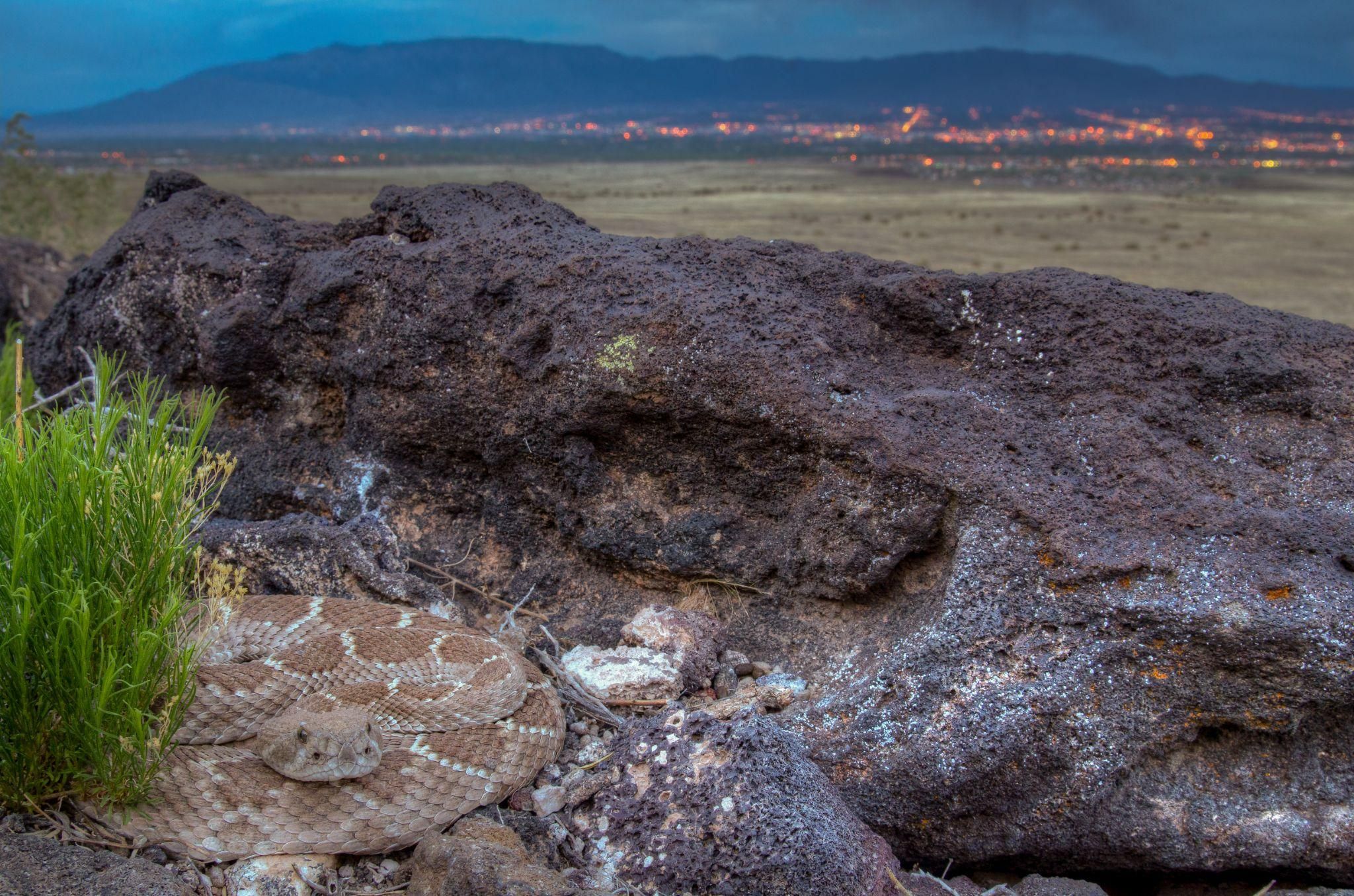
Credit: Bill Gorum
All snakes are beneficial and play an important role in New Mexico’s ecosystems, being both predator and prey. Most snakes, including six of the ten rattlesnake species in New Mexico, feed heavily on rodents. In New Mexico, this means that snakes have the important job of controlling the spread of infectious diseases like hantavirus and bubonic plague. Snakes only bite when they are harassed or feel threatened; they are not naturally aggressive towards humans. Venomous snakes can only produce a finite amount of venom, which is primarily used to subdue prey. The last thing that any snake wants to do is waste its valuable venom in self-defense. That being said, a bite is one of the few defenses a legless animal like a snake possesses, and snakes may bite in self-defense in a life-threatening situation. Most bites occur when people harass animals, so please do not handle venomous reptiles without proper training and equipment. Imagine being poked and prodded, or even stepped on, by a creature around two-hundred times your body weight! This is why it is critical for anyone spending time outdoors in New Mexico to take snake safety into consideration.
In addition to the rattle being an important way to distinguish rattlesnakes from harmless species, there are some other general rules that can be helpful. Unlike most nonvenomous snakes in New Mexico, rattlesnakes possess thick, blocky heads that house heat-sensing pits near the nostrils and venom-producing glands behind the eyes. Many rattlesnakes are relatively heavy-bodied, though there are some exceptions, like the desert massasauga. Many harmless species will mimic rattlesnakes by flattening their heads, flattening their bodies to appear larger, and vibrating their tails. This is why it is important to avoid focusing on any single identifier when looking at a snake. Take into account the head, the body, the rattle, and any unique identifying features outlined for each species in this publication.
You don’t need to learn how to recognize every species of snake to be safe, but learning about the few snakes that can pose a potential threat to you, your loved ones, and your pets can make all the difference. If you can’t determine whether a snake is venomous with 100% certainty, your best bet is to just leave it alone. Both you and the snake will be better off for it. There are many field guides and web resources that provide a wealth of information on each of these species, and these are valuable learning tools that will be referenced later, but this publication aims to simplify the identification of New Mexico’s venomous reptiles in an easy-to-use, quick reference format that can be useful for readers ranging from weekend hikers to seasoned field biologists. The photos, which were generously provided by excellent wildlife photographers, researchers, and reptile enthusiasts, aim to show not only the identifying features of each species, but also the habitats and behaviors of these incredible animals.
How to Use This Publication
Description
Each species profile begins with a description of the physical attributes and identifying features of the animal. Any key identifying features are accompanied by a photograph.
Similar Species
While many of the venomous reptiles of New Mexico are unique, some of them do appear quite similar to others. This section will provide the reader with helpful tips to distinguish these species from others and will also point you in the direction of which other species profile you should reference if you are still uncertain. Information about harmless species that are commonly misidentified as venomous snakes can be found in its own section at the end of the publication.
Geographic Distribution in New Mexico
New Mexico distribution maps have been provided for each species. We include these maps because if you are not near where a particular species is likely to occur, you are probably looking at a different species. These maps show county boundaries and use point data sourced from iNaturalist and/or GBIF (Global Biodiversity Information Facility). These points tell us exactly where individuals of a species have been observed, but they can’t necessarily tell us the extent of an animal’s distribution. They just tell us where individual animals have been encountered by a relatively small group of people—those who upload their observations to iNaturalist or GBIF. To make up for this information deficit, we have created distribution maps that use ecological subregion data from the United States Department of Agriculture (USDA) Forest Service. The colored portions of the maps do not guarantee presence of a species, nor do the uncolored portions guarantee absence. They do, however, illustrate regions that contain potentially suitable habitat for each species, therefore indicating the possible presence of the species in question. Still, mountains, plains, and other geographic barriers, which prevent the natural spread of the species, may exist within the shaded areas. In some instances, these maps may differ significantly from more conservative distribution maps found in field guides, but the purpose of our maps is to predict where occasional outliers and vagrant individuals may pop up in future observations, and maybe even to inspire wildlife enthusiasts and naturalists to search for the animals in those areas and provide the scientific community with geographic data by uploading their observations to iNaturalist or a similar platform.
Habitat and Ecology
We have included a section for each species to describe the habitats where the snakes and lizards may be encountered. This can be valuable, especially for visitors in the backcountry or rural landowners who may be curious about which species could potentially be living alongside them on their property. Ecological information, such as what the snakes eat and what kind of shelter they prefer can inform homeowners on how to minimize unwanted run-ins with venomous species. For example, encounters with a species that specializes in eating rodents can be mitigated with effective rodent control and prevention. Please avoid poisons! Poisons can hurt beneficial predators other than snakes, such as raptors or mammalian carnivores. By gaining an awareness of habitat and ecological information for the species in your area, you can have a better idea of which habitat types involve a greater chance for an encounter with a venomous reptile.
Additional Information
This section will detail any additional facts about the animal that we think the reader may find interesting. This may include information about venom, as well as a reiteration of the fact that every bite by a venomous reptile should be treated seriously and medical attention should be sought immediately. Other interesting notes in this section may include information about conservation status and threats to the species.
Reticulate Gila Monster (Heloderma suspectum suspectum)
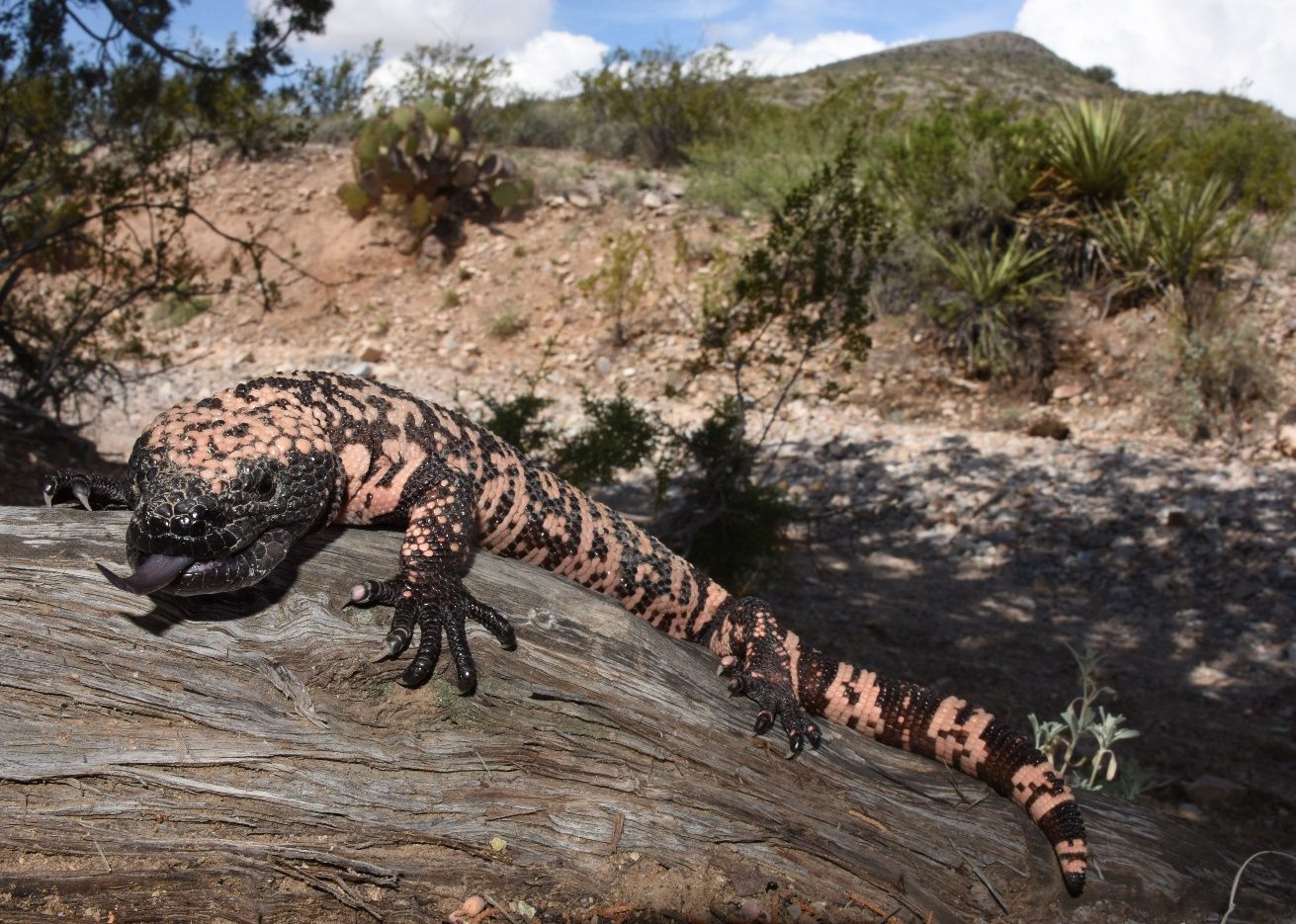
Credit: Wolfgang Wüster
Description
Weighing in at up to 2 pounds and measuring up to almost two feet, the Gila monster is the largest lizard native to New Mexico and the United States and the only native venomous lizard. The body of the Gila monster is covered with bumps (Figure 4A). Just like an alligator or crocodile, the bumps are actually little bones in the skin called osteoderms, which provide a layer of protection against potential predators like coyotes or birds of prey.
The Gila monster is divided into two subspecies, the reticulate Gila monster (Heloderma suspectum suspectum) and the banded Gila monster (Heloderma suspectum cinctum). Only the reticulate Gila monster can be found in New Mexico, so this description will focus on that subspecies. Both are extremely similar and easily recognized as Gila monsters, though, so the rest of the information is relevant for both subspecies.
The bumpy skin is covered in an intricate pattern of orange and black. The tail is often quite bulbous, as it is used to store fat to sustain the animal in times when food is scarce.
Like a snake’s tongue, the Gila monster’s fleshy, forked tongue (Figure 2) is used to detect odors and help the lizard find a meal or detect a threat.
Similar Species
There are no other brightly colored orange and black lizards in New Mexico. Gila monsters do not possess the tremendous speed of other lizards. If it quickly runs away when approached, it is probably not a Gila monster.
Geographic Distribution in New Mexico
In New Mexico, the range of the Gila monster is generally considered to be limited to four counties in the southwest: Hidalgo, Grant, Luna, and Doña Ana. Individuals have occasionally been found in neighboring counties, but it is unclear if the lizards made it there naturally or were transported by humans.
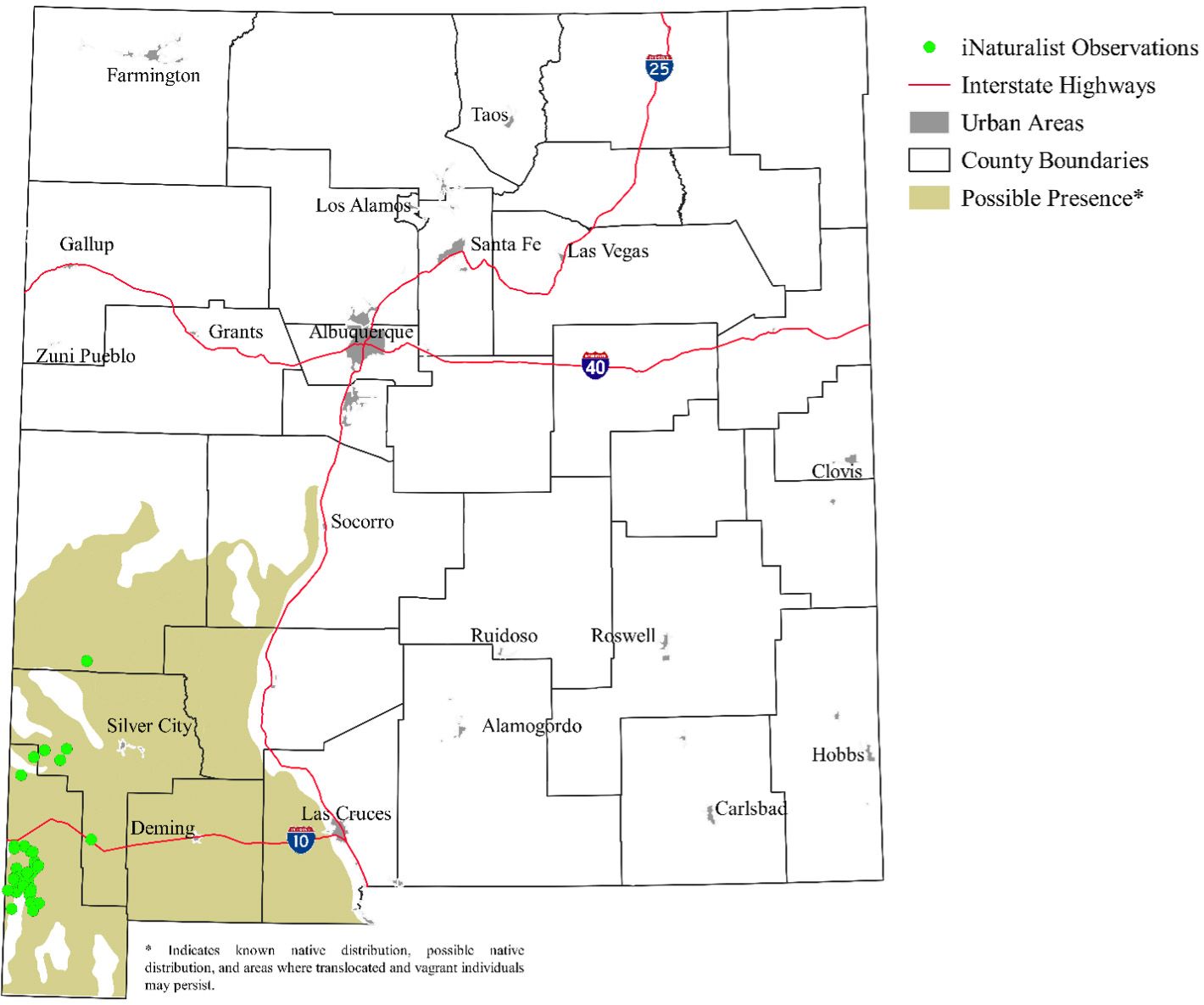
Credit: Brandon Bourassa, UF/IFAS
Habitat and Ecology
Typical habitat for Gila monsters in New Mexico is rocky desert uplands and grasslands. Throughout their range, they can also be found in desert, chaparral, and woodland habitat.
Slow moving and lumbering, Gila monsters specialize in feeding on baby mammals and ground-nesting birds, as well as the eggs of birds and other reptiles. They do occasionally wander into residential areas in rural communities and the outskirts of towns. Removing cover for ground-nesting birds and mammals will reduce the likelihood that a Gila monster will take up residence on your property.
Additional Information
Despite their fearsome reputation, bites from Gila monsters are exceedingly rare and are almost never unprovoked. A bite can cause severe pain but is not considered life-threatening to humans. That being said, if you are bitten by a Gila monster, you should seek medical attention immediately, as allergies to any venom can lead to serious complications in some people.
Gila monsters are listed as “Near Threatened” by the Red List of Threatened Species developed by the International Union for the Conservation of Nature (IUCN). This designation means that, while they are not in immediate risk of extinction, a relatively minor decrease in their overall population or a decrease in or fracturing of suitable habitat could move them into a “Threatened” category. Due to this risk, the Gila monster is protected throughout its range in the United States. All states in their range prohibit the collection of Gila monsters without proper permits. Some states, like Arizona, enforce steep fines for even getting close enough to a Gila monster to alter its behavior. It is best to appreciate these beautiful animals from afar, and always call a licensed professional or the New Mexico Department of Game and Fish if an animal must be removed from your property.

Credit: A. Brandon Bourassa, UF/IFAS; B, C, D, and E. Bryan Hughes, Rattlesnake Solutions
Sonoran Coral Snake (Micruroidis euryxanthus euryxanthus)
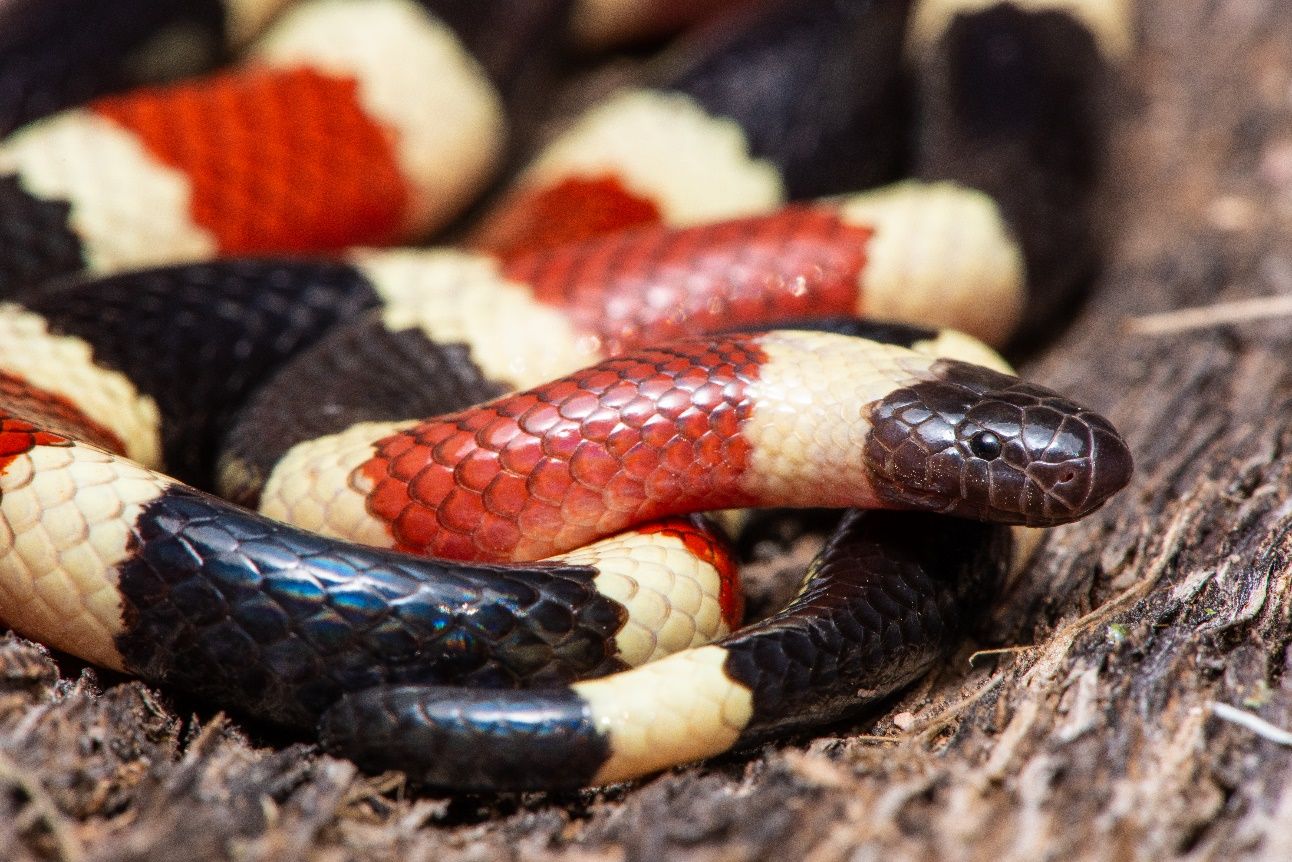
Credit: Wolfgang Wüster
Description
Coral snakes are small, slender snakes that range from about 13 to 21 inches long. These attractive, tri-colored snakes have broad, alternating bands of black and bright red that are separated by substantially narrower yellow or white bands (Figure 5). These bands encircle the entire body but are not as vibrant on the snake’s belly. The head of the Sonoran coral snake is black, with the first yellow band just behind the head. The repeating pattern of yellow, red, yellow, black, yellow, red, yellow, black, etc. follows down the length of the body.
Similar Species
You have probably heard some variation of the old adage, “Red and black, venom lack. Red and yellow, kill a fellow.” However, this method of identification just doesn’t cut it for this species. Several harmless snakes in New Mexico and the Southwest have red bands touching yellow. One important distinction is that the bands of a coral snake completely encircle the body (although you shouldn’t be inspecting a snake’s belly if you are not 100% certain that it is harmless). The black head gives way to a band of yellow on the neck, followed by a red band. Harmless milk snakes will also have a black head followed by a band of yellow, but the next band will be black. The harmless snakes that you should familiarize yourself with at the end of this publication are the ground snake (Figure 41C), long-nosed snake (Figure 41D), New Mexico milksnake (Figure 42D), and Arizona mountain kingsnake (Figure 42F).
Geographic Distribution in New Mexico
The Sonoran coral snake has been documented in Hidalgo, Grant, and Catron counties in southwestern New Mexico. Tri-colored snakes in other regions are likely harmless, but you should refer to the “Commonly Misidentified Harmless Snakes” section at the end of this publication to confirm.
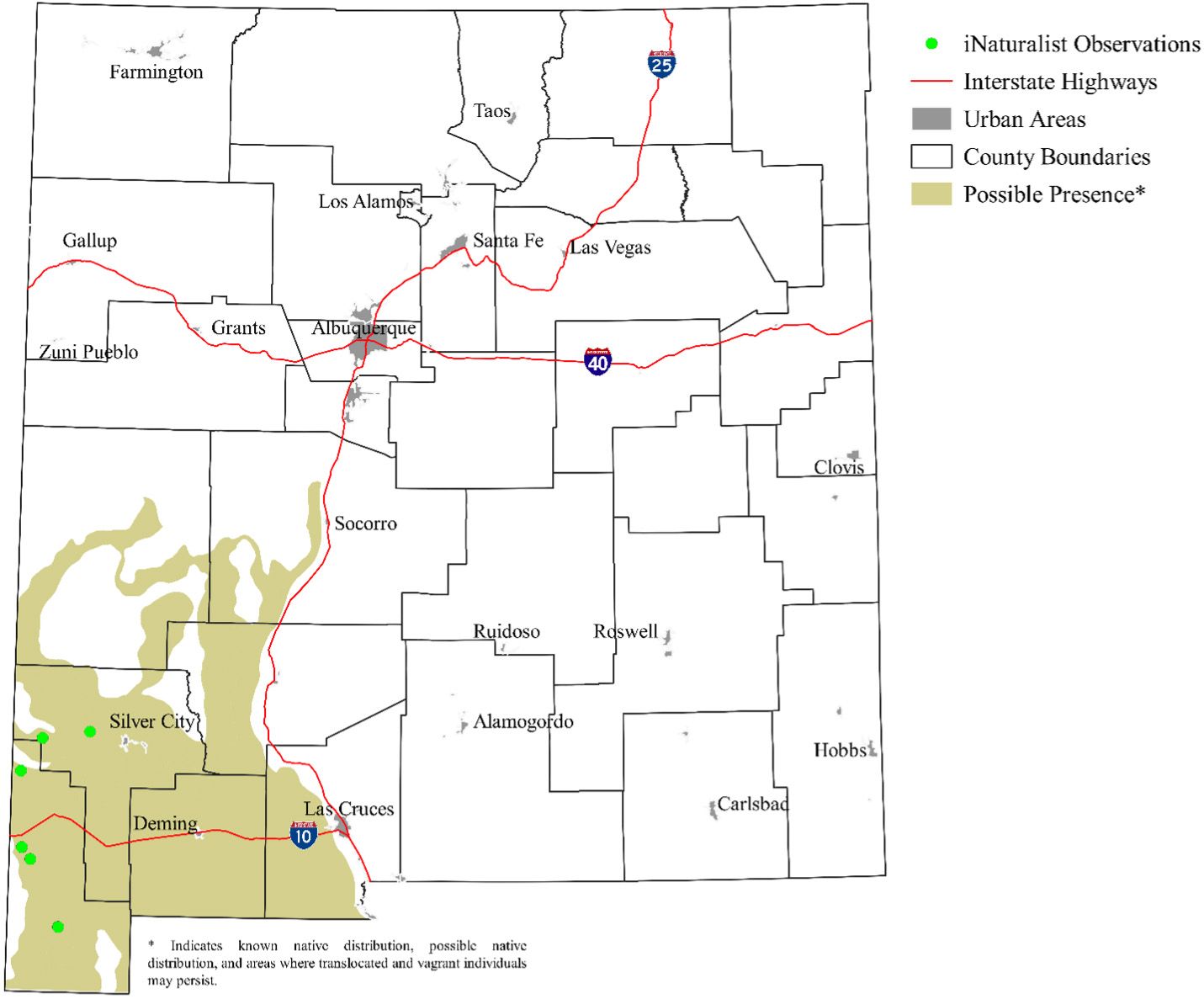
Credit: Brandon Bourassa, UF/IFAS
Habitat and Ecology
This species is found in a variety of habitats, but they are most often found in areas with rocky terrain. They can also be found in grasslands, wooded areas, desert-scrub, and thornscrub.
Coral snakes feed primarily on small reptiles, especially smaller snakes like blind snakes. Active at night, these reclusive snakes are sometimes seen crossing roads in search of prey.
As a defense, coral snakes will roll their tail into a ball in an attempt to confuse predators into attacking the tail instead of the head (Figure 7C and 7D).
Additional Information
Unlike rattlesnakes and all other venomous snakes in North America, coral snakes belong to a family of snakes called Elapids. Other Elapids that you are probably familiar with are cobras, mambas, and sea snakes. Coral snakes have a reputation of being a deadly snake, and, drop for drop, the venom is certainly potent. However, because they are such small snakes, the amount of venom injected in a bite from a coral snake tends to be substantially less than the venom injected in a bite from a rattlesnake. Still, a bite from a coral snake can kill. Seek medical attention immediately if you are bitten.
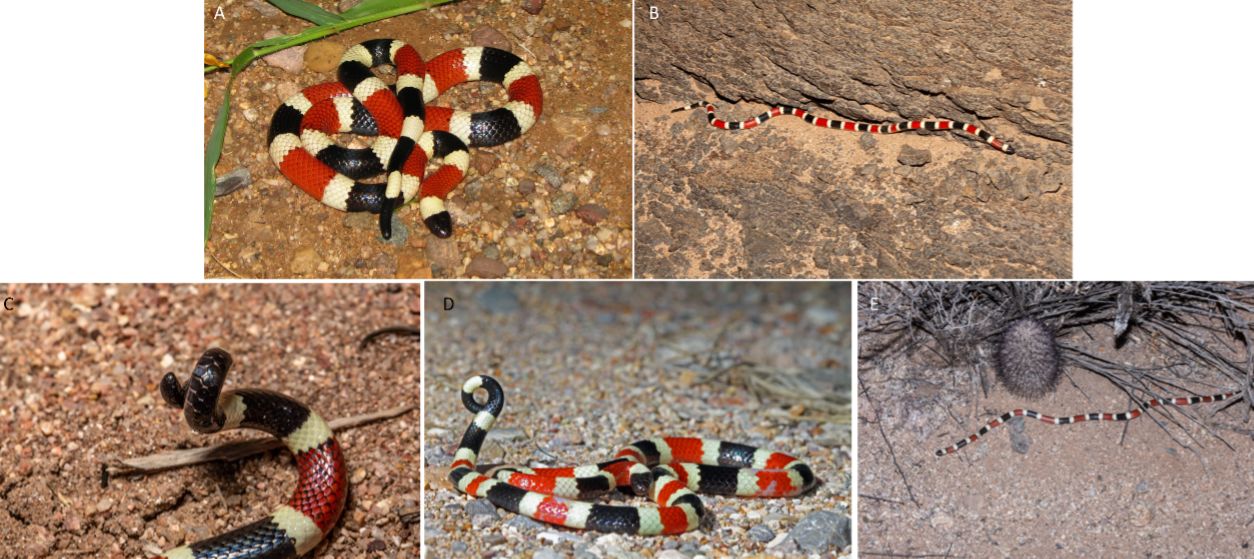
Credit: A. Richard Reams; B, C, and E. Bryan Hughes, Rattlesnake Solutions; D. Wolfgang Wüster
Western Diamondback Rattlesnake (Crotalus atrox)
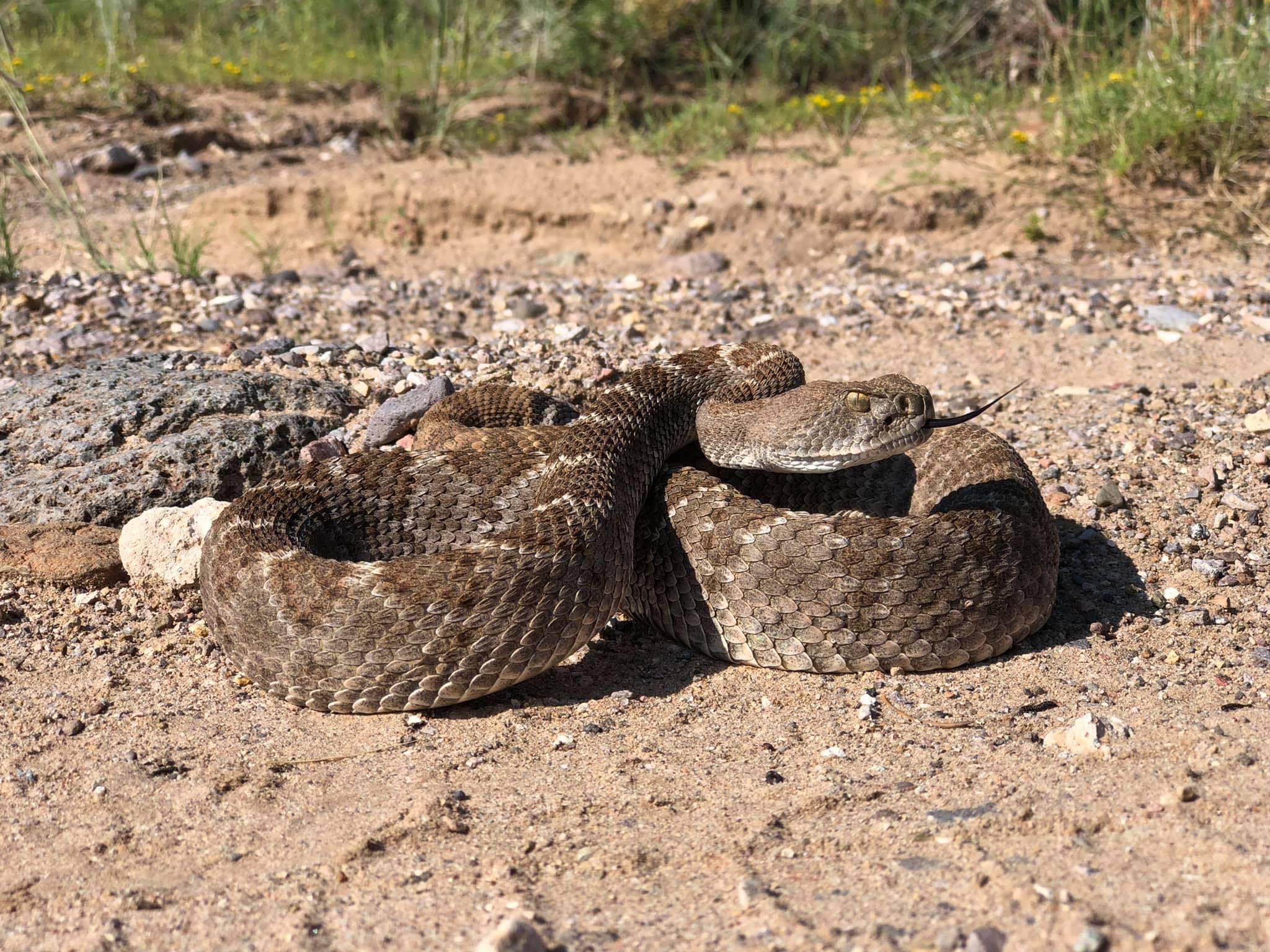
Credit: Brandon Bourassa, UF/IFAS
Description
Western diamondback rattlesnakes are, without a doubt, one of the most recognizable and iconic animals of the American Southwest. It is the largest venomous snake in New Mexico (usually up to about 5 feet, very rarely up to about 6 feet), and the second largest in the United States, just behind the eastern diamondback. In New Mexico, the black and white striped tail (Figure 10B and 10E) is the quickest way to identify this rattlesnake (see the “Similar Species” section for tips on how to distinguish from the similar tail of some Mojave rattlesnakes). At the tip of the tail is the obvious rattle (a trait that is shared by all rattlesnakes in New Mexico). The background color of the body is usually a light, dusty brown or gray, with darker “diamonds” in a repeating pattern from the base of the neck to the start of the black and white banding on the tail. The “diamonds” are outlined by a white or light tan color. In some areas, such as Hidalgo County, the base color takes an almost pink tinge. Some specimens near Santa Fe tend to have a darker reddish tinge to the base coloration.
Similar Species
Mojave rattlesnakes may appear similar but can be readily distinguished by the banding on the tail (Figure 26). Some individuals may have black and white banding present, but the width of the black and white bands is uneven. The light bands on the tail are also usually more tan than white, but this may be difficult to discern in low light or without a photo of a western diamondback to compare it to. While there are exceptions, generally, western diamondbacks have bands of roughly equal width.
Prairie rattlesnakes may also appear similar but lack the black and white banding on the tail (Figure 32).
Lighter individuals of Arizona black rattlesnakes (Figure 13E) may be confused for western diamondbacks, but their range in New Mexico is limited to a small portion of Catron County, where western diamondbacks are not likely to be present. Again, they also lack the black and white banding on the tail.
Geographic Distribution in New Mexico
With the exception of the five northernmost counties, as well as Catron and Curry Counties, the western diamondback occurs throughout the state. Residents in all three population centers of Santa Fe, Albuquerque, and Las Cruces should familiarize themselves with this species, as well as similar species in those areas.
This species is likely absent from Catron, San Juan, Rio Arriba, Taos, Colfax, and Union Counties because the high-elevation, mountainous terrain is not ideal. Conversely, the open prairies of Curry County lack the rocky outcrops and other geographic features that western diamondbacks rely on as den sites.

Credit: Brandon Bourassa, UF/IFAS
Habitat and Ecology
Western diamondbacks can be found in a variety of habitat types across New Mexico. From foothills, to dry arroyos, to rocky outcrops, to wooded habitat. They generally do not do well in urban settings, being heavily persecuted but are often encountered by residents on the edges of populated areas like Santa Fe, Albuquerque, and Las Cruces. They are unlikely to be found at elevations greater than around 8,000 feet, but even higher elevations are not out of the question.
In the winter, western diamondback rattlesnakes hibernate in communal den sites. Dens are commonly found on rocky slopes (often facing east), and may be outcrops, small caves, or even abandoned mine shafts. These dens are frequently shared with other species of snakes, including other rattlesnakes. In the early spring and late fall, western diamondbacks can often be found at or near the entrances to their dens (Figure 10E), sometimes soaking up the sun in small congregations.
Western diamondbacks are opportunistic predators, which means that they are unlikely to pass up the opportunity for a meal. They will eat a variety of prey, but most commonly consume rodents and other small mammals (Figure 10D). Lizards and small birds also fall prey to these snakes if the opportunity arises. One of the best ways to prevent western diamondbacks from taking up residence on your property is by reducing the amount of prey available to them. Simple actions like keeping up with your yard maintenance and removing brush and debris that might attract rodents can discourage western diamondbacks from making your yard their home. Removing structures that may have fallen into disrepair is also likely to reduce rodent populations, in turn reducing the likelihood of encounters with rattlesnakes.
Additional Information
The venom of western diamondback rattlesnakes is medically significant. It is primarily a hemotoxin, meaning that it attacks the blood vessels, arteries, blood cells, and heart. While there is always the possibility of a “dry bite,” meaning that no venom was injected, every bite from a western diamondback should be treated as a life-or-death situation. If you are bitten by this species, or any rattlesnake, you should seek medical attention immediately.
Western diamondbacks are one of the most persecuted species in the United States. On top of the pressures caused by expanding urban and residential landscapes, events known as “rattlesnake roundups” are still occurring in parts of their range, like Texas and Oklahoma. These events encourage participants to collect and slaughter thousands of animals every year in what they claim to be a public service, ignoring the impacts on the environment and ecology of the ecosystems from which the animals are removed. However, many of these events have transitioned to festivals that celebrate rattlesnakes, focusing on education rather than misguided eradication efforts. We suggest attending these more sustainable and ecologically friendly events.
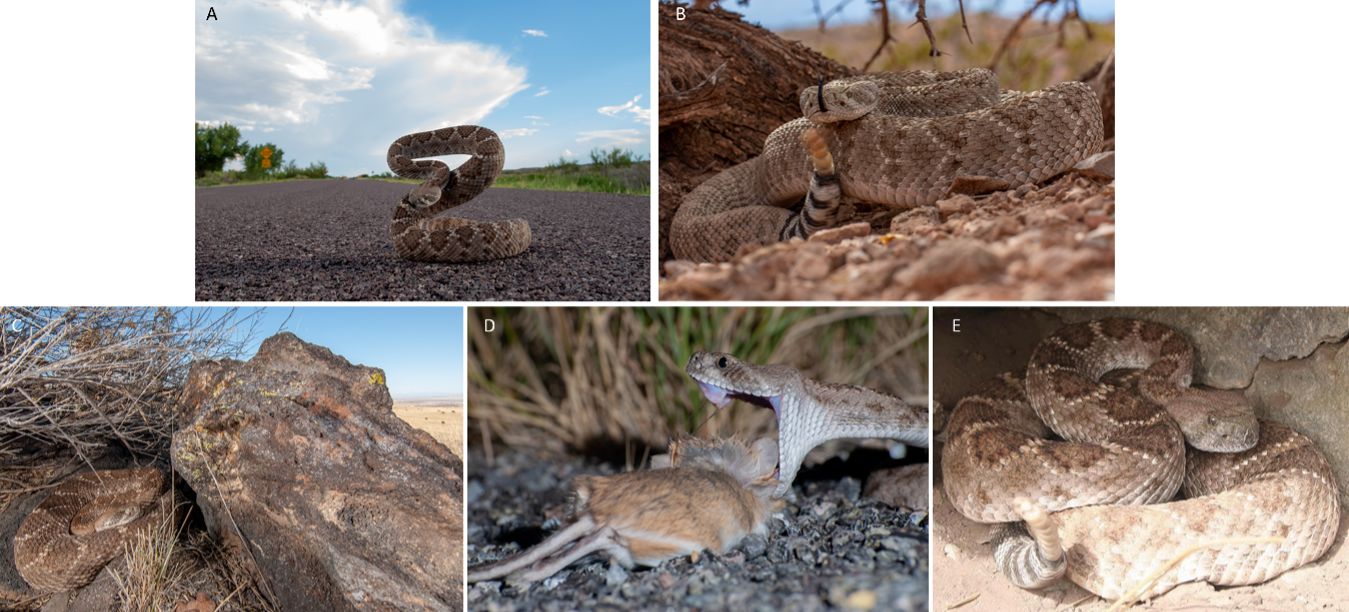
Credit: A, B, C, and D. Bill Gorum; E. Brandon Bourassa, UF/IFAS
Arizona Black Rattlesnake (Crotalus cerberus)

Credit: Bryan Hughes, Rattlesnake Solutions
Description
The Arizona black rattlesnake is a medium- to large-bodied snake (up to about 42 inches long) that ranges from light grey to mostly black. Young of this species are light grey (Figure 13B) and gradually darken as they age. Young have light brown blotches along the length of the back, while adults have narrow yellow to white or gray crossbars on the black background.
Similar Species
Lighter individuals may look like prairie rattlesnakes, but the two species do not generally overlap in New Mexico due to differences in habitat preferences.
Geographic Distribution in New Mexico
In New Mexico, the Arizona black rattlesnake is limited to parts of Grant and Catron Counties in and around the Gila National Forest.

Credit: Brandon Bourassa, UF/IFAS
Habitat and Ecology
This rattlesnake inhabits a variety of higher-elevation habitats (up to about 8,500 feet), including woodlands, chaparral, and semi-desert grasslands. They are also commonly found in rocky arroyos and drainages, as well as talus (sloped terrain covered in loose boulders and fragments of rock from slides) and outcrops. Due to its limited range in New Mexico, this species is unlikely to be encountered in urban or residential areas, but visitors to the Gila National Forest should be familiar with this snake.
Much like the western diamondback, the Arizona black rattlesnake is an opportunistic hunter that will consume a variety of prey items, including rodents, birds, and lizards.
Additional Information
The venom of this species contains a potent hemotoxin. Bites can be serious if left untreated. Seek medical attention immediately if you have been bitten by an Arizona black rattlesnake.
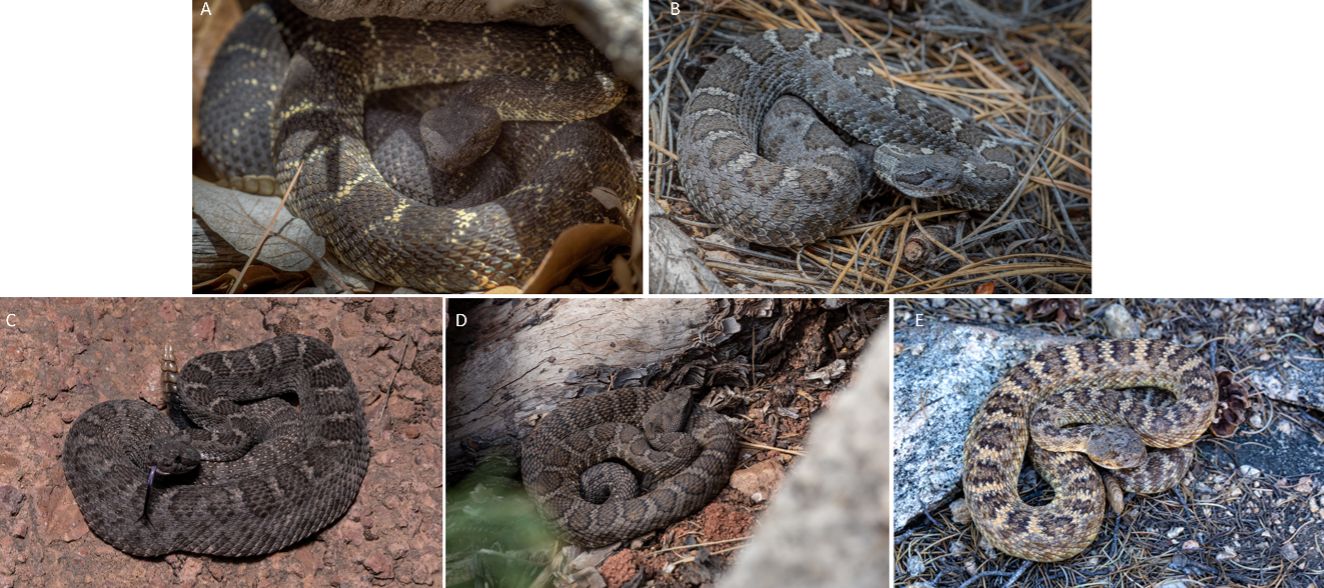
Credit: A and B. Bill Gorum; C, D, and E. Bryan Hughes, Rattlesnake Solutions
Banded Rock Rattlesnake (Crotalus lepidus klauberi)
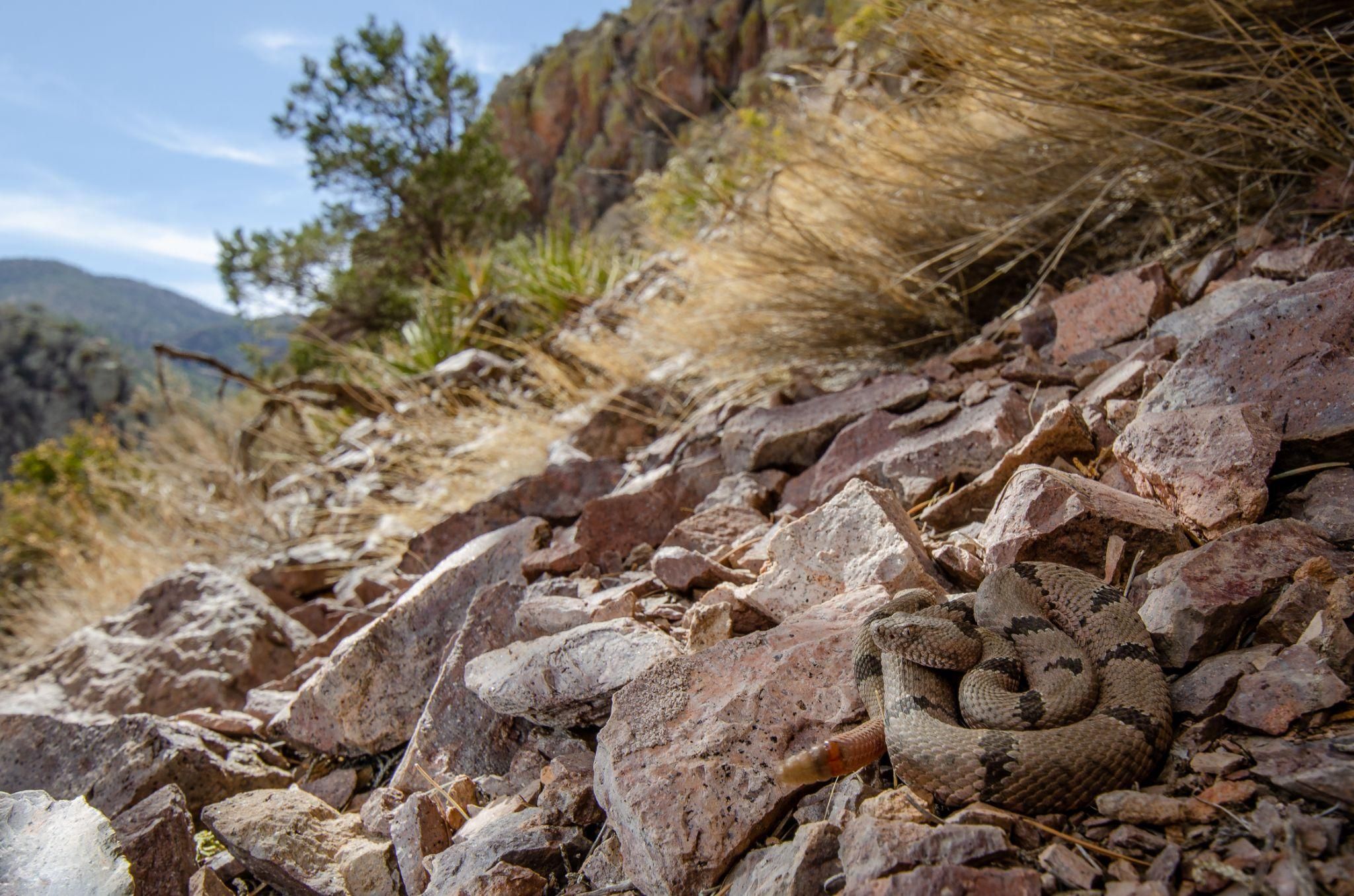
Credit: Bill Gorum
Description
New Mexico is home to two distinct subspecies of rock rattlesnake: the banded rock rattlesnake and the mottled rock rattlesnake. For the purposes of this publication, we have elected to split them into two sections because of the physical and geographic distinctions between them.
A small-bodied snake (roughly 22 inches long on average), the banded rock rattlesnake is well-adapted to its habitat. The beautiful light gray body with dark gray to black banding makes it stand out in comparison to other rattlesnakes but enables it to disappear into its surroundings with excellent camouflage.
Similar Species
There are no similar species in New Mexico. As mentioned previously, however, there are two subspecies of rock rattlesnakes present in New Mexico. The mottled rock rattlesnake can be easily distinguished if you are familiar with the geographic ranges of both snakes, and additional identifying features will be detailed in the subsequent section.
In the “Commonly Misidentified Harmless Snakes” section of this publication, familiarize yourself with lyre snakes (Figure 42B), night snakes (Figure 42C), and gray-banded kingsnakes (Figure 42E). These species could reasonably be misidentified as banded rock rattlesnakes.
Geographic Distribution in New Mexico
The banded rock rattlesnake is found in mountainous areas in the southwestern quadrant of the state. They can be found in Socorro, Catron, Sierra, Grant, Doña Ana, Luna, and Hidalgo Counties.

Credit: Brandon Bourassa, UF/IFAS
Habitat and Ecology
This montane species inhabits a variety of rocky habitats at elevations ranging from about 4,000 feet up to about 8,500 feet. This is another species that is not commonly found in urban or residential areas and is seldom seen crossing roads, with the exception of some mountain roads that have been cut through rocky terrain.
Banded rock rattlesnakes prefer lizards as prey, but will also take frogs, small rodents, and small birds if the opportunity arises. Young have been documented eating insects.
Additional Information
The venom of this species is a mixture of hemotoxin and neurotoxin that varies in potency throughout its geographic range, likely due to differences in prey availability. For example, a population in the Magdalena Mountains of Socorro County might possess a venom that is better adapted for subduing lizards, like crevice spiny lizards (Sceloporus poinsettii), whereas a population living in an area with a higher proportion of rodent prey might have a venom better adapted to subduing mammals. If you are bitten by this species, or any rattlesnake, you should seek medical attention immediately.

Credit: A. Buddy Brown; B, C, and D. Bill Gorum; E. Josh Emms
Mottled Rock Rattlesnake (Crotalus lepidus lepidus)
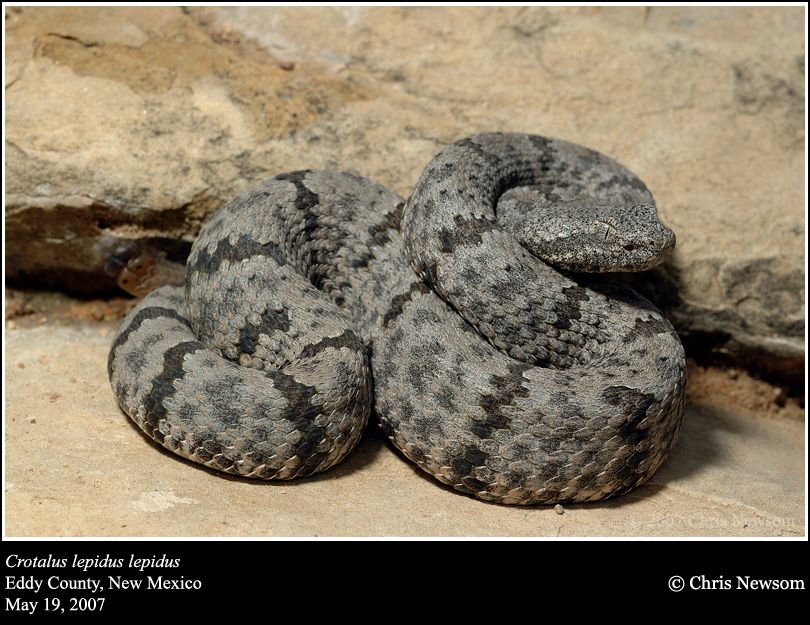
Credit: Chris Cirrincione
Description
Mottled rock rattlesnakes appear very similar to banded rock rattlesnakes. Both generally have a background coloration of some shade of gray, but the mottled rock rattlesnake usually lacks the solid banding that is common in the banded rock rattlesnake. Instead, as the name suggests, there is a darker gray to black mottling in place of the bands. Some individuals, however, do have more solid bands and can be more difficult to distinguish from banded rock rattlesnakes. However, their ranges in New Mexico generally do not overlap, so geography is the best tool to positively identify them.
Similar Species
Other than their closely related cousin, the banded rock rattlesnake, there are no other venomous snakes in New Mexico that can be easily confused with the mottled rock rattlesnake. However, in the “Commonly Misidentified Harmless Snakes” section of this publication, familiarize yourself with lyre snakes (Figure 42B), night snakes (Figure 42C), and gray-banded kingsnakes (Figure 42E). These species could reasonably be misidentified as mottled rock rattlesnakes.
Geographic Distribution in New Mexico
These snakes are generally associated more with the mountains of southwestern Texas, northern Chihuahua, and Coahuila. The range of the mottled rock rattlesnake in New Mexico extends only into Otero and Eddy Counties in the south. Remembering this simple fact is the easiest way to distinguish the two subspecies in New Mexico; if it is west of Otero County, it is probably a banded rock rattlesnake.
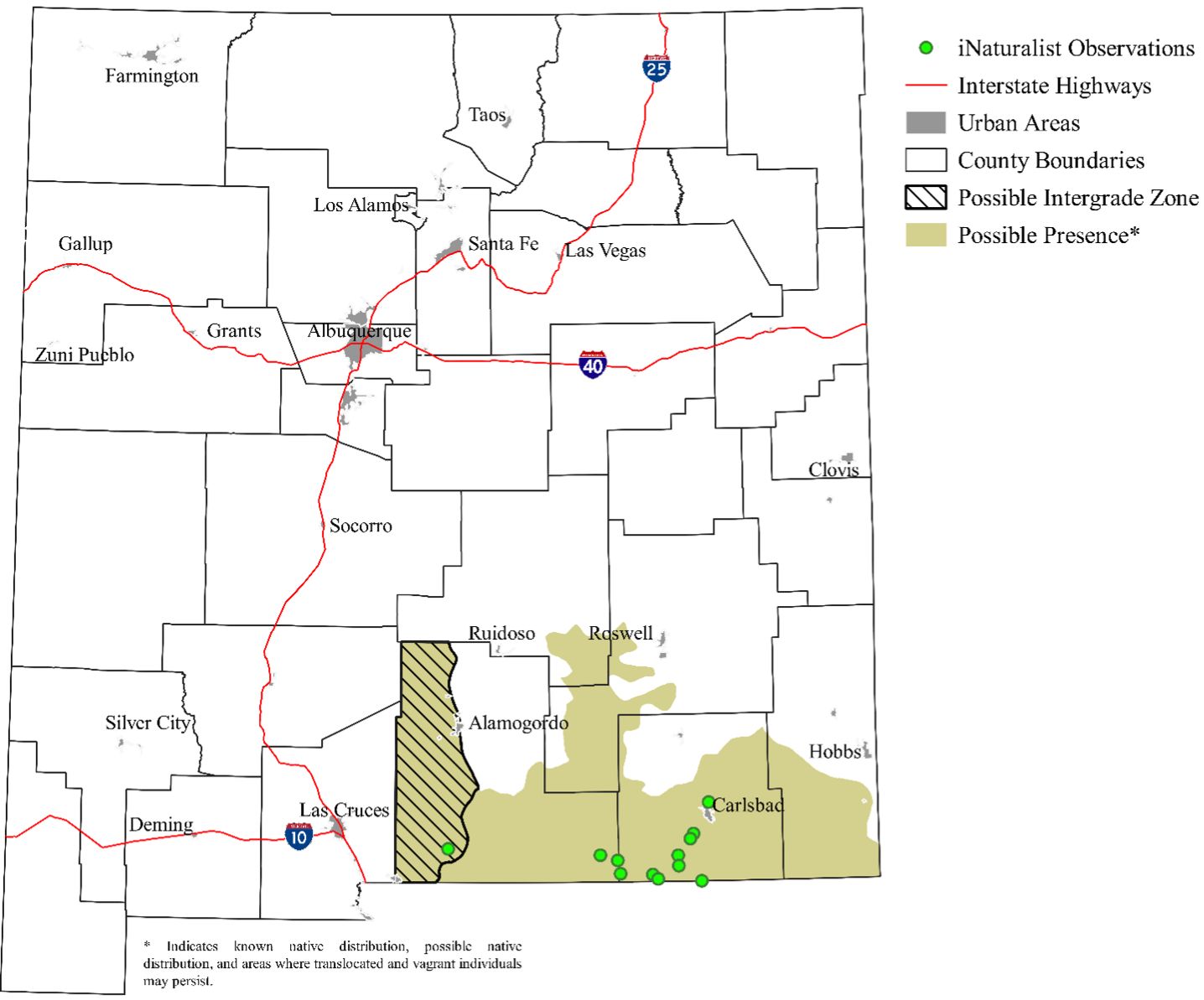
Credit: Brandon Bourassa, UF/IFAS
Habitat and Ecology
The habitat requirements and behavioral ecology of this subspecies are very similar to those of the banded rock rattlesnake. Both species prefer rocky, mountainous terrain, including outcroppings and talus.
Lizards, frogs, small rodents, and small birds make up the bulk of the adult diet. Juveniles may feed on insects.
Additional Information
Although the venom yield from a mottled rock rattlesnake might be comparatively small, the venom is quite potent and should be treated very seriously. The venom is primarily hemotoxic, meaning that it attacks the blood vessels and arteries, but it may have some serious neurotoxic effects as well. If you are bitten by this species, or any rattlesnake, you should seek medical attention immediately.
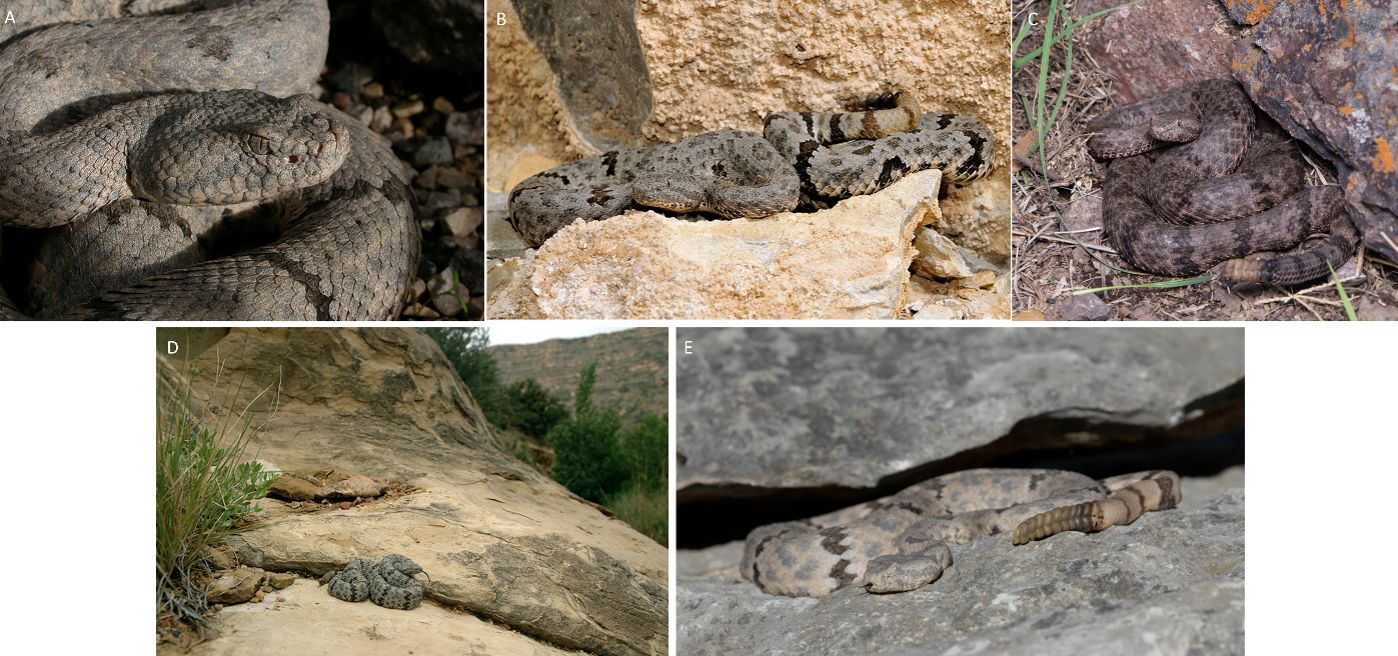
Credit: A, B, and D. Chris Cirrincione; C and E. Ashley Wahlberg
Eastern Black-Tailed Rattlesnake (Crotalus ornatus)
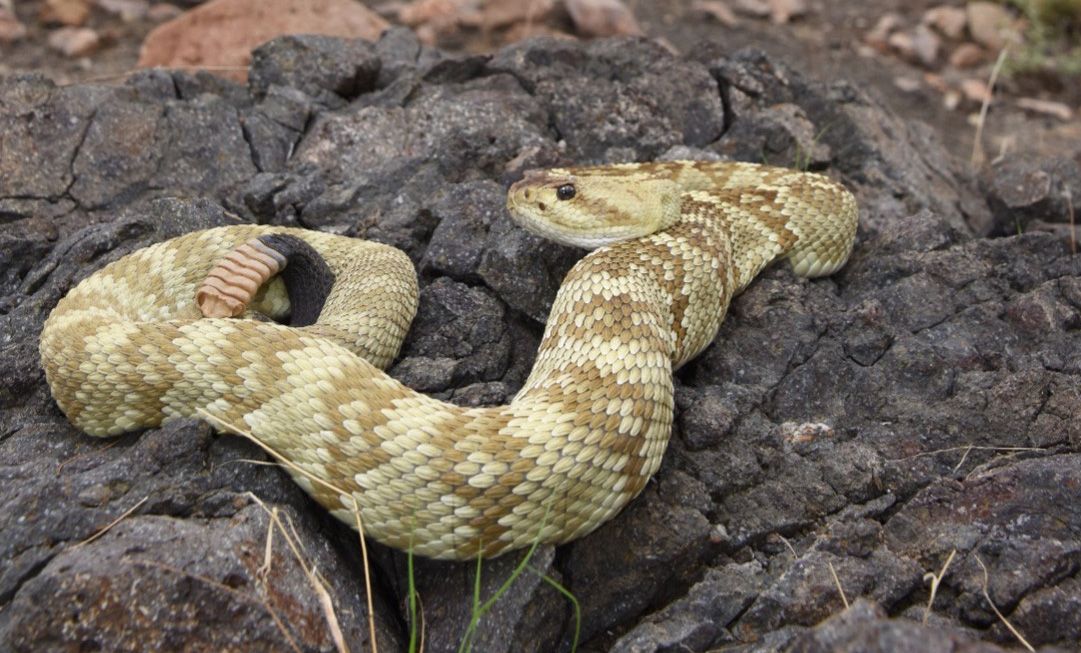
Credit: Wolfgang Wüster
Description
Sometimes called the ornate black-tailed rattlesnake or green rattler, the eastern black-tailed rattlesnake can be quite variably colored. Background coloration ranges from light brown or tan to gray, or even gray with a greenish tinge. Jagged brown or black blotches with patches of lighter scales on the interior of each blotch line the length of the back down to the solid black tail that gives this snake its name. A large-bodied snake, adults can reach 22 inches to 48 inches long.
Similar Species
Eastern black-tailed rattlesnakes share New Mexico with the northern black-tailed rattlesnake. Because they appear almost identical, the best way to distinguish between the two species is by location: in other words, where you spot the snake. Their geographic distributions generally do not overlap. In areas where both species occur, it may be best to take a photo from a safe distance and ask an expert, who will probably identify the species based on differences in the number of scales on the head.
Eastern black-tailed rattlesnakes are sometimes confused with Mojave rattlesnakes. This confusion is likely to occur in Otero or Hidalgo Counties, where both species are present, but Mojave rattlesnakes generally prefer lowlands and desert flats, while eastern black-tailed rattlesnakes prefer the rocky uplands. Of course, there are exceptions, so you can always ask an expert for a positive identification if you are able to obtain a photograph from a safe distance. If you hear someone in Albuquerque say that they saw a “Mojave green” while hiking the La Luz Trail, they most likely saw an eastern black-tailed rattlesnake.
Geographic Distribution in New Mexico
Eastern black-tailed rattlesnakes can be found in rocky, wooded uplands throughout much of the interior of New Mexico. They are probably the most common rattlesnake found in the foothills of the Sandia Mountains and the Organ Mountains. Residents of Albuquerque and Las Cruces should familiarize themselves with this species.
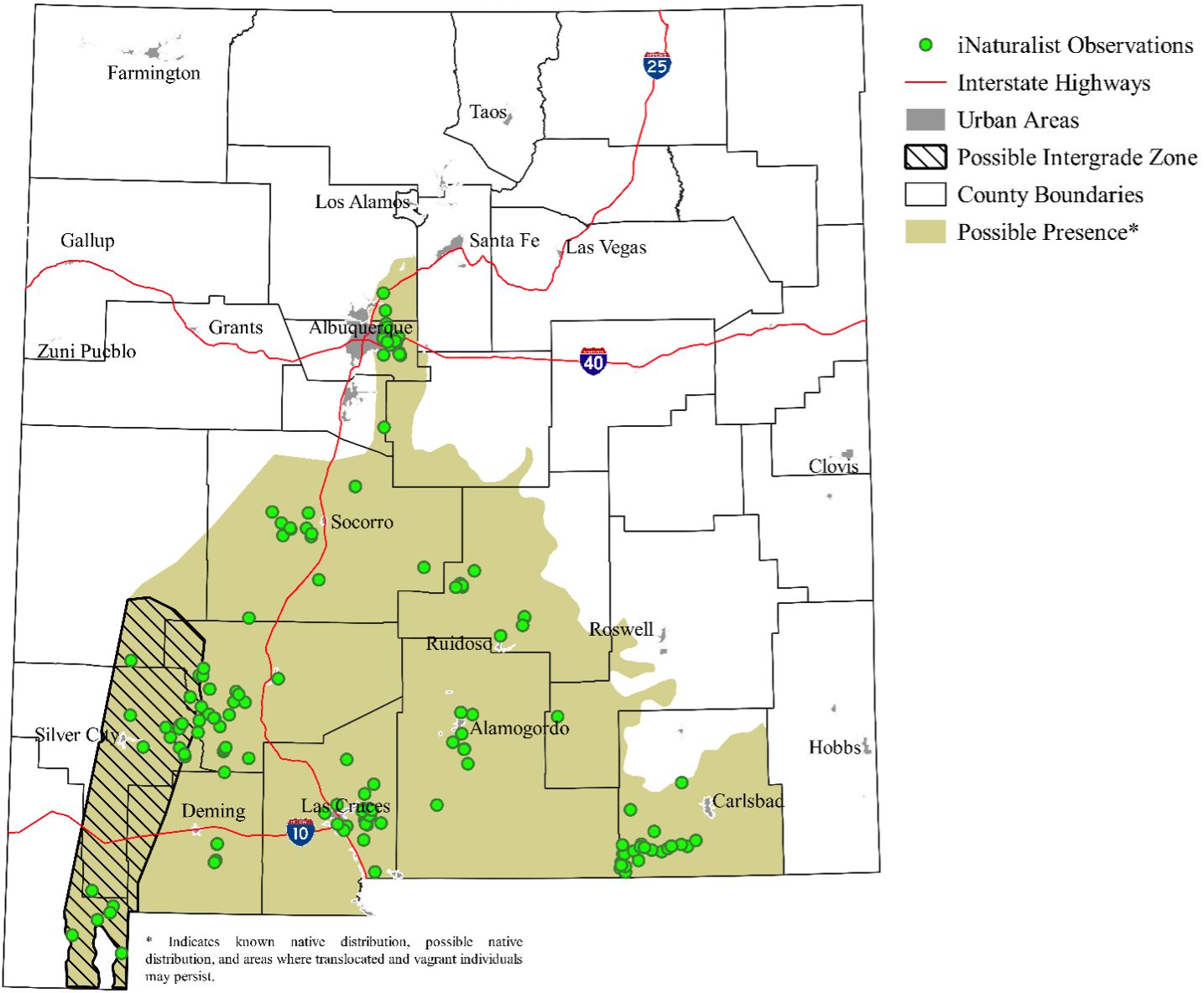
Credit: Brandon Bourassa, UF/IFAS
Habitat and Ecology
The preferred habitat for eastern black-tailed rattlesnakes is rocky valleys and arroyos and rocky, wooded uplands up to 8,000 feet in elevation. They generally do not associate with residential and urban environments, except in newer developments in foothill areas like those in Placitas or Albuquerque east of Tramway Boulevard, for example. This species hibernates in communal dens, and has been known to share dens with western diamondbacks and rock rattlesnakes. Like many rattlesnake species, the eastern black-tailed rattlesnake gives birth to young in a nursery den (Figure 22B), where young can be safely guarded by other adult females. Lizards, rodents, small rabbits, and birds make up the bulk of the eastern black-tailed rattlesnake’s diet.
Additional Information
The eastern black-tailed rattlesnake was only recently classified as a separate species from the northern black-tailed rattlesnake. Genetic research carried out and published by Chris Anderson and Eli Greenbaum in 2012 revealed that, although they may look identical at first glance, there are enough genetic and morphological differences to classify Crotalus ornatus as its own species.
Eastern black-tailed rattlesnakes are one of the more docile species of rattlesnakes. Some individuals may not even rattle when approached cautiously. Do not make the mistake of thinking that they will not bite, however. If provoked, this species will still deliver a serious bite requiring immediate medical attention. If you are bitten by this species, or any rattlesnake, you should seek medical attention immediately.
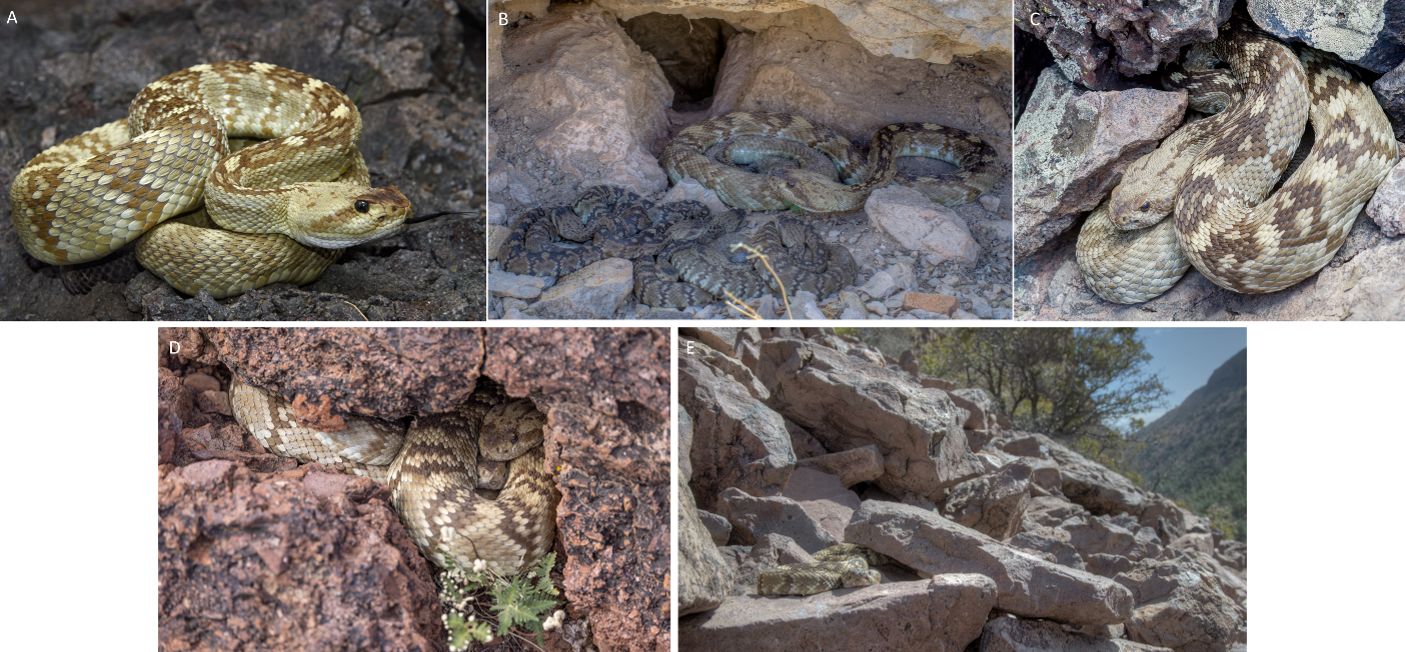
Credit: A. Wolfgang Wüster; B, C, D, and E. Bill Gorum
Northern Black-Tailed Rattlesnake (Crotalus molossus)
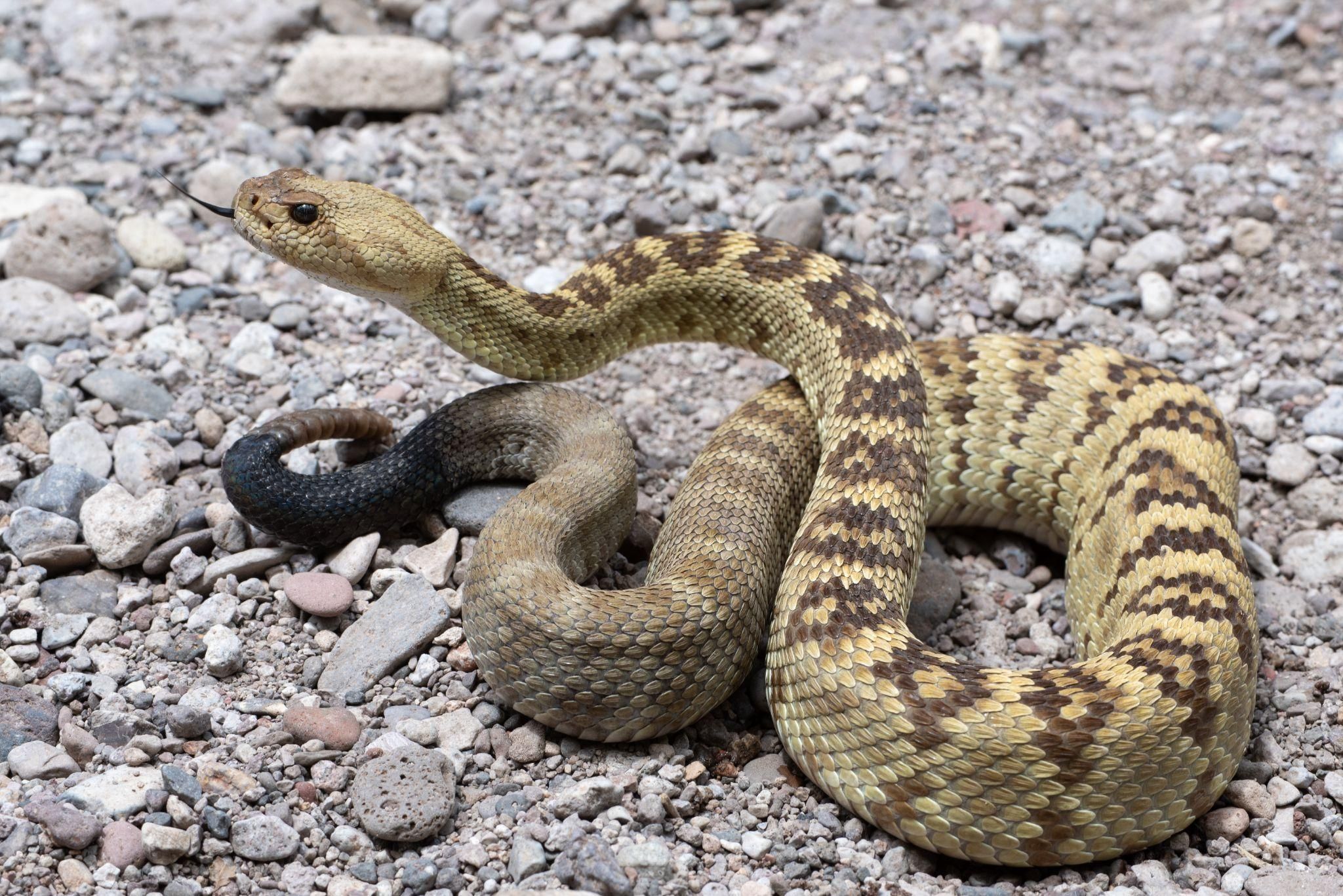
Credit: Bill Gorum
Description
Both species of black-tailed rattlesnakes in New Mexico look virtually identical to the casual observer. They both have the gray background coloration, but the northern black-tailed rattlesnake may have a more yellowish background coloration in parts of its range. Because the physical appearance of these two species is so similar, most people recognize geography as the best tool for differentiating them. Only professionals should attempt to identify the species based on differences in scalation.
Similar Species
As previously mentioned, the eastern black-tailed rattlesnake can appear nearly identical to the untrained eye. While there are methods for making positive identifications, they require the observer to be much closer than we recommend. If you encounter one of these beautiful snakes in the wild, take note of which county you made the observation in and make your identification based on that. You can also upload an image (taken from a safe distance) to iNaturalist and let an expert attempt to make a positive identification.
Geographic Distribution in New Mexico
The range of the northern black-tailed rattlesnake in New Mexico is limited to four western counties. It extends north into Cibola County and down through Catron, Grant, and Hidalgo Counties.
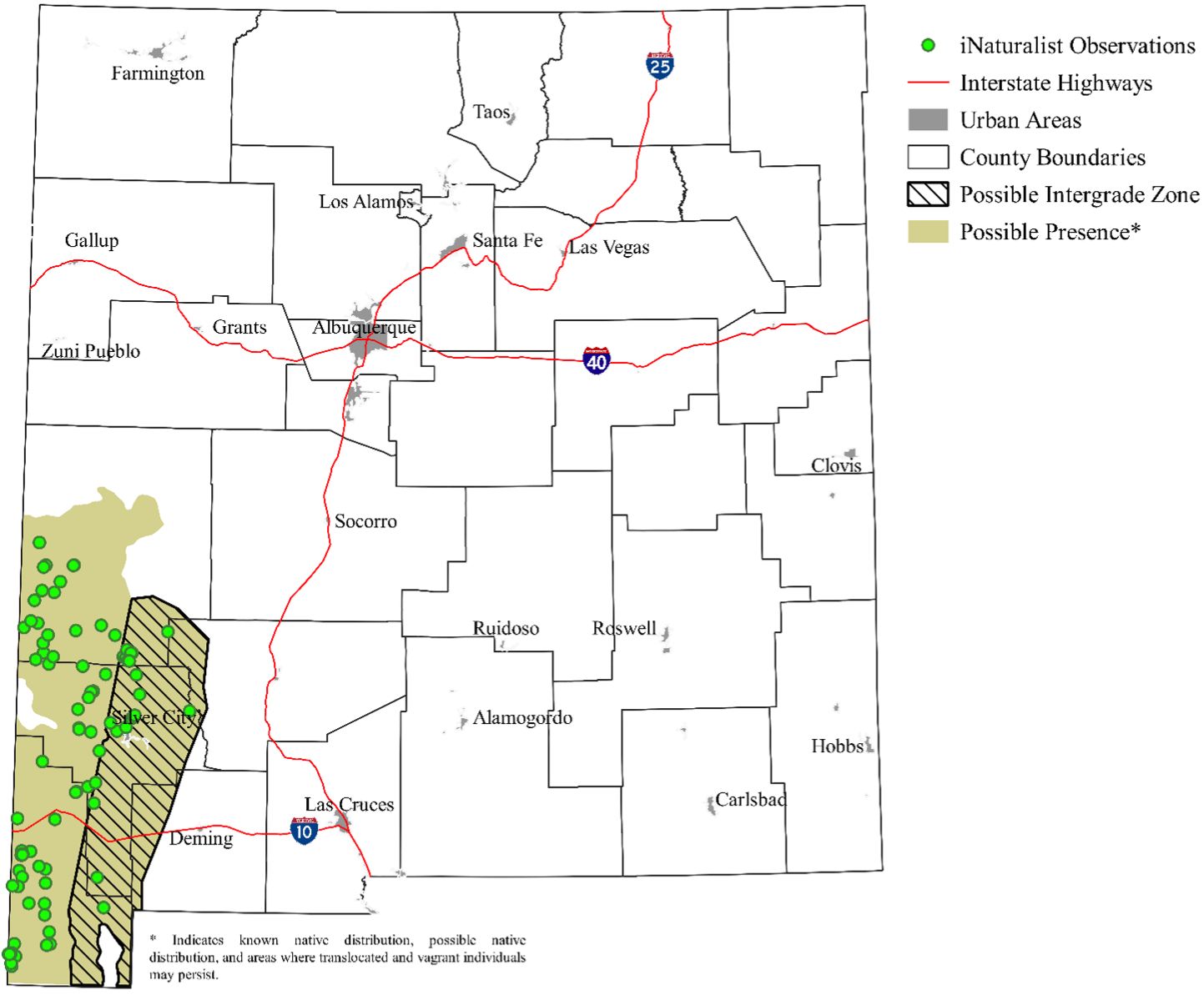
Credit: Brandon Bourassa, UF/IFAS
Habitat and Ecology
Generally associated with foothills, this species can be found in rocky and/or wooded habitats upwards of 8,000 feet in elevation. In some parts of their range, however, they may be found more commonly in canyons and rocky desert near cliffs.
The prey of the northern black-tailed rattlesnakes consists of lizards, small mammals, and birds.
Additional Information
The eastern and northern black-tailed rattlesnakes were classified as the same species (Crotalus molossus) until Anderson & Greenbaum (2012) published their research into the morphological and molecular differences between the two populations and designated the eastern population as Crotalus ornatus.
Although this species is comparatively docile when compared to other rattlesnakes, if provoked, it will still deliver a serious bite requiring immediate medical attention. If you are bitten by this species, or any rattlesnake, you should seek medical attention immediately.
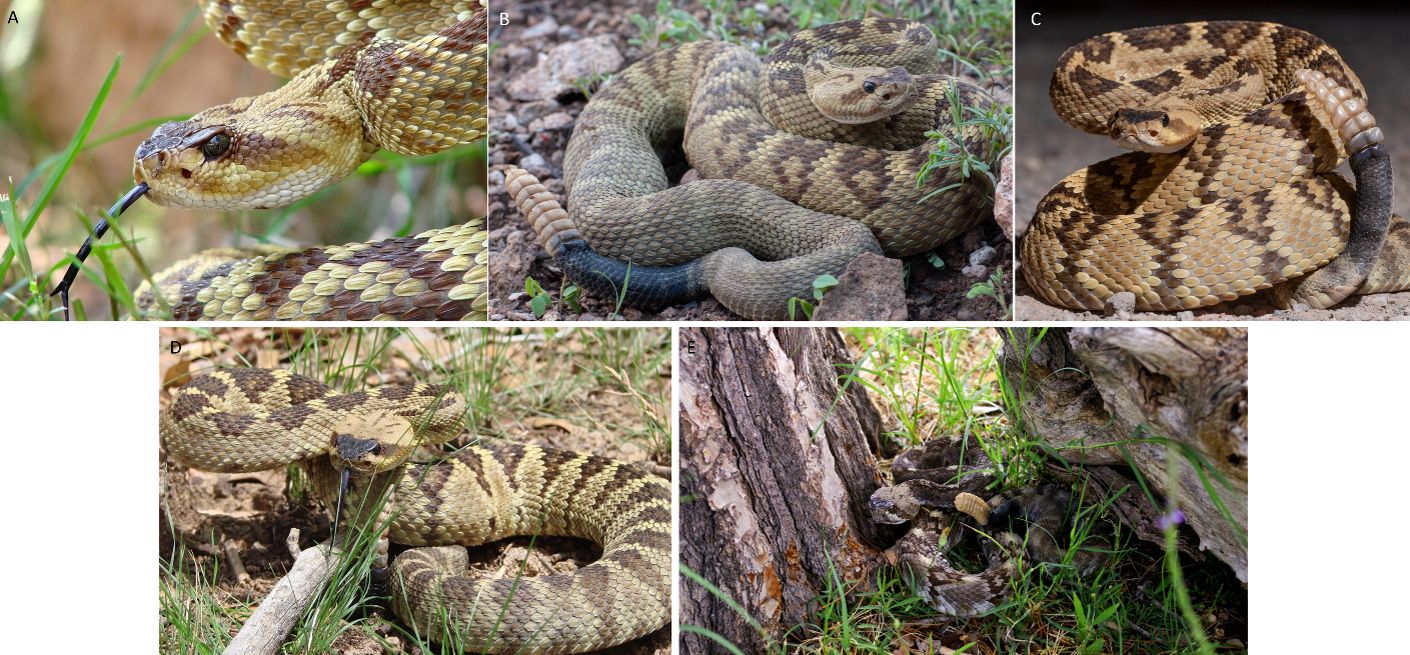
Credit: A and D. Buddy Brown; B and C. Bill Gorum; E. Ashley Wahlberg
Mojave Rattlesnake (Crotalus scutulatus)

Credit: Bill Gorum
Description
When threatened, these rattlesnakes will stand up tall in the classic “S” pose (Figure 28D), ready to strike at immediate threats. The body is tan or light brown with dark blotches forming a pattern down the length of the back. The tail is banded with wide light bands (usually tan to almost white) and narrow dark bands (dark brown to almost black).
Similar Species
These rattlesnakes are similar in appearance to both prairie rattlesnakes and western diamondbacks. In fact, in parts of Hidalgo County in southwestern New Mexico, they commonly hybridize with prairie rattlesnakes. They can easily be distinguished from prairie rattlesnakes by the presence of black and almost white or tan bands on the tail, and the bands can be distinguished from those on a western diamondback by their width. The light tail bands on a Mojave rattlesnake are wider than the dark bands, and if the tail is elevated in a defensive posture (Figure 26), you will see that the tail bands do not wrap around underneath the body as they do on a western diamondback. These bands are sometimes uneven and may resemble a checkerboard pattern. (If the snake doesn’t happen to oblige you by holding its tail up for examination, we strongly discourage approaching to get a better look.)
Geographic Distribution in New Mexico
The Mojave rattlesnake is known to occur in two counties in New Mexico. They are commonly encountered in Hidalgo County near Rodeo, as well as parts of southern Otero County. Occasional individuals have been found near Anthony in Doña Ana County, but it is unclear if there is a nearby population or if these individuals are outliers.
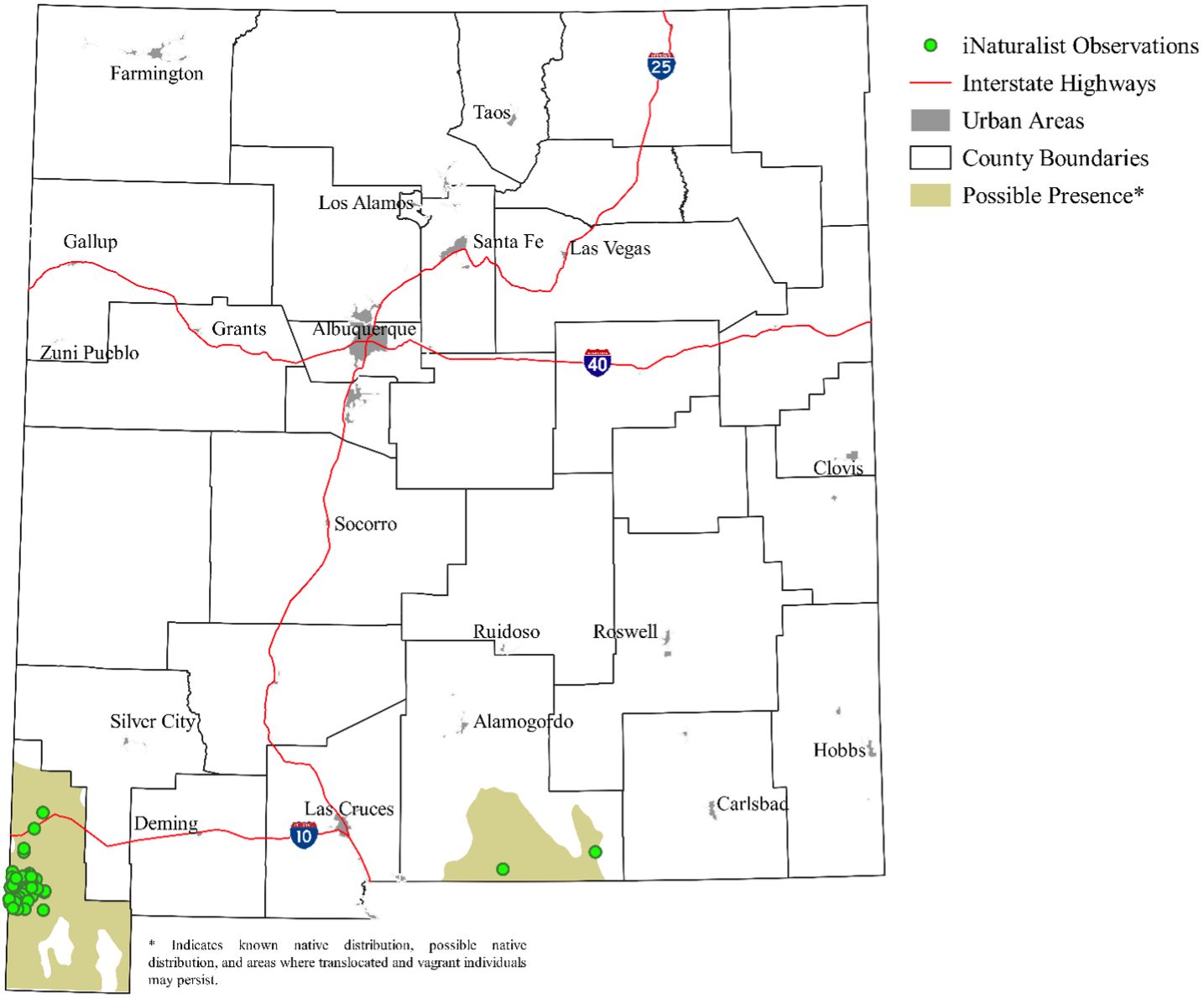
Credit: Brandon Bourassa, UF/IFAS
Habitat and Ecology
Mojave rattlesnakes generally occur in open grasslands, prairies, and desert scrub habitats. They are commonly seen crossing roads in southwestern New Mexico and often fall victim to passing cars.
Rodents and lizards make up the bulk of the Mojave rattlesnake’s diet, but other small animals, such as ground-nesting birds, will be readily consumed if the opportunity arises.
Additional Information
Many people will incorrectly tell you that Mojave rattlesnakes are the most “aggressive” of all rattlesnakes. While they sometimes put on an impressive and intimidating show when threatened, in reality, they just want you to leave them alone so they can go about their business. An unprovoked rattlesnake will never chase or attack a human.
Mojave rattlesnakes possess a potent mixture of neurotoxic (attacks the nervous system) and hemotoxic (attacks muscles and tissues) venom that can be deadly if the victim does not seek immediate medical treatment. If you are bitten by this species, or any rattlesnake, you should seek medical attention immediately.
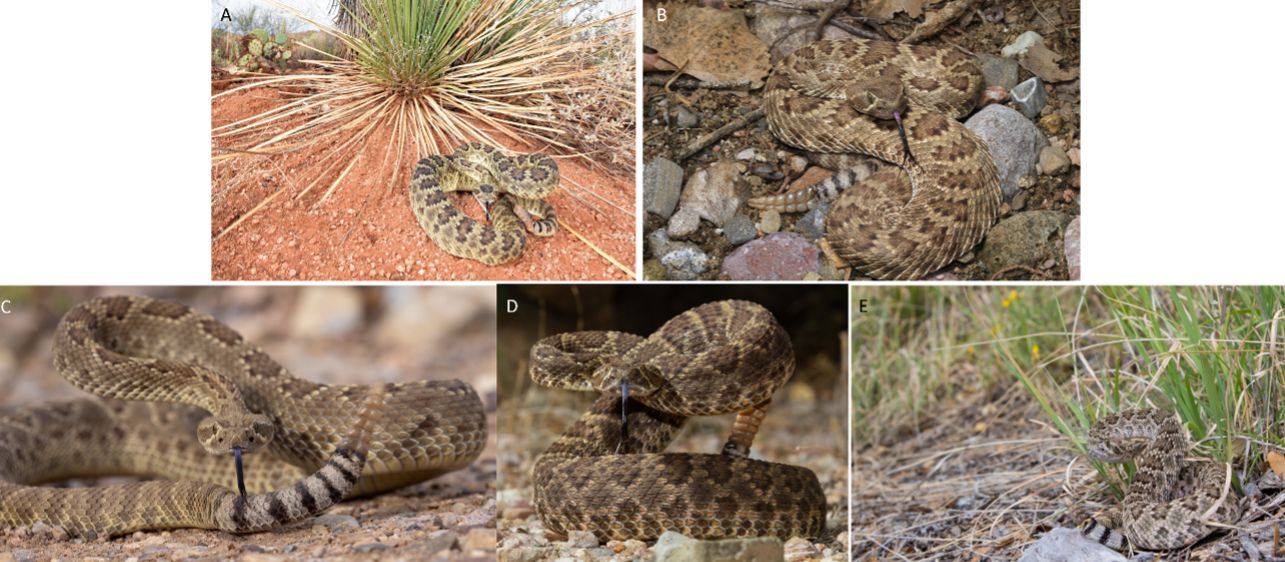
Credit: A, B, and D. Wolfgang Wüster; C. Bill Gorum; E. Ashley Wahlberg
Tiger Rattlesnake (Crotalus tigris)
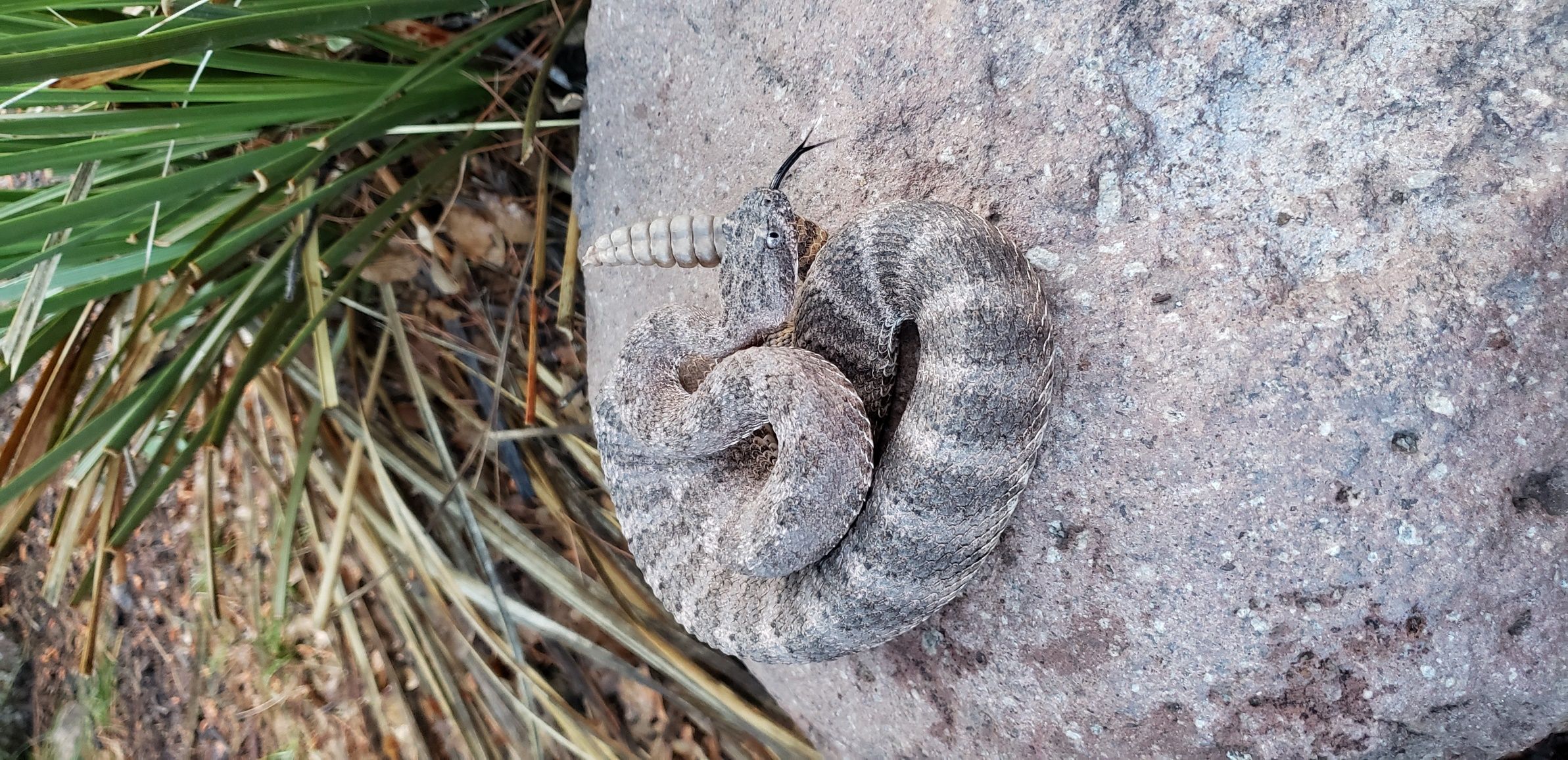
Credit: Kyle Vargas
Description
The tiger rattlesnake gets its name from the repeating pattern of gray stripes on a light gray to white background. A comparatively smaller rattlesnake, adults reach about 18 to 36 inches long. In fact, the largest specimen on record was 35.9 inches. These snakes have a small head that can almost seem too small for their bulky bodies.
Similar Species
The most similar species in New Mexico, as far as size and coloration, is the rock rattlesnake. The rock rattlesnake has a less bulky body and tends to have more pronounced and less frequent dark banding.
Geographic Distribution in New Mexico
Only recently discovered to be present in New Mexico, this animal is unlikely to be encountered except by the most adventurous hikers and outdoor enthusiasts in the southwestern corner of the state. They are known only from the Peloncillo Mountains in Hidalgo County, and only a handful of specimens have been confirmed, so any adventurers and community scientists looking to contribute valuable data for researchers might want to make a weekend trip to search for this elusive animal and add more location records for New Mexico. Even if the search is unsuccessful, you’ll still find yourself exploring one of the most beautiful regions of North America, so you can definitely still consider it a win.
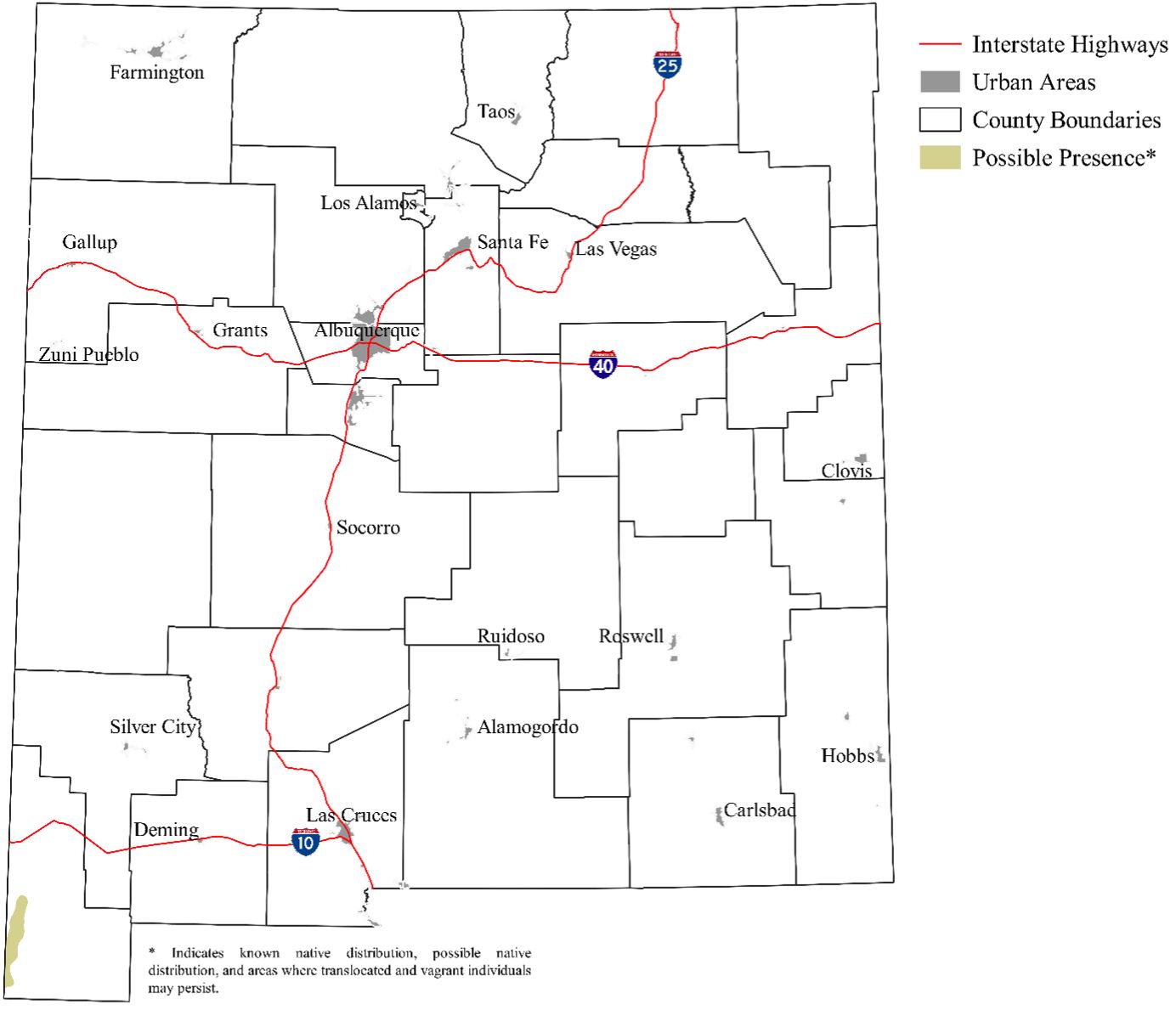
Credit: Brandon Bourassa, UF/IFAS
Habitat and Ecology
Tiger rattlesnakes are found in rocky canyons and foothills throughout their range in Arizona and Mexico. The population in Hidalgo County and adjacent Cochise County, Arizona, is separated by a significant geographic distance from the rest of the known distribution, and the animals found there in the Peloncillo Mountains tend to occupy rocky foothills and dry mountain stream beds.
Tiger rattlesnakes prey on small mammals and lizards, using their venom to subdue their prey. Drop for drop, their venom is among the most toxic of all rattlesnake species, containing a potent mixture of neurotoxin (attacks nerve tissue) and myotoxin (causes muscle necrosis). If you are bitten by this species, or any rattlesnake, you should seek medical attention immediately.
Additional Information
For more information on the recent range extension of this species into New Mexico, see Brown (2020).

Credit: A. Bill Gorum; B, C, and D. Bryan Hughes, Rattlesnake Solutions; E. Kyle Vargas
Prairie Rattlesnake (Crotalus viridis)
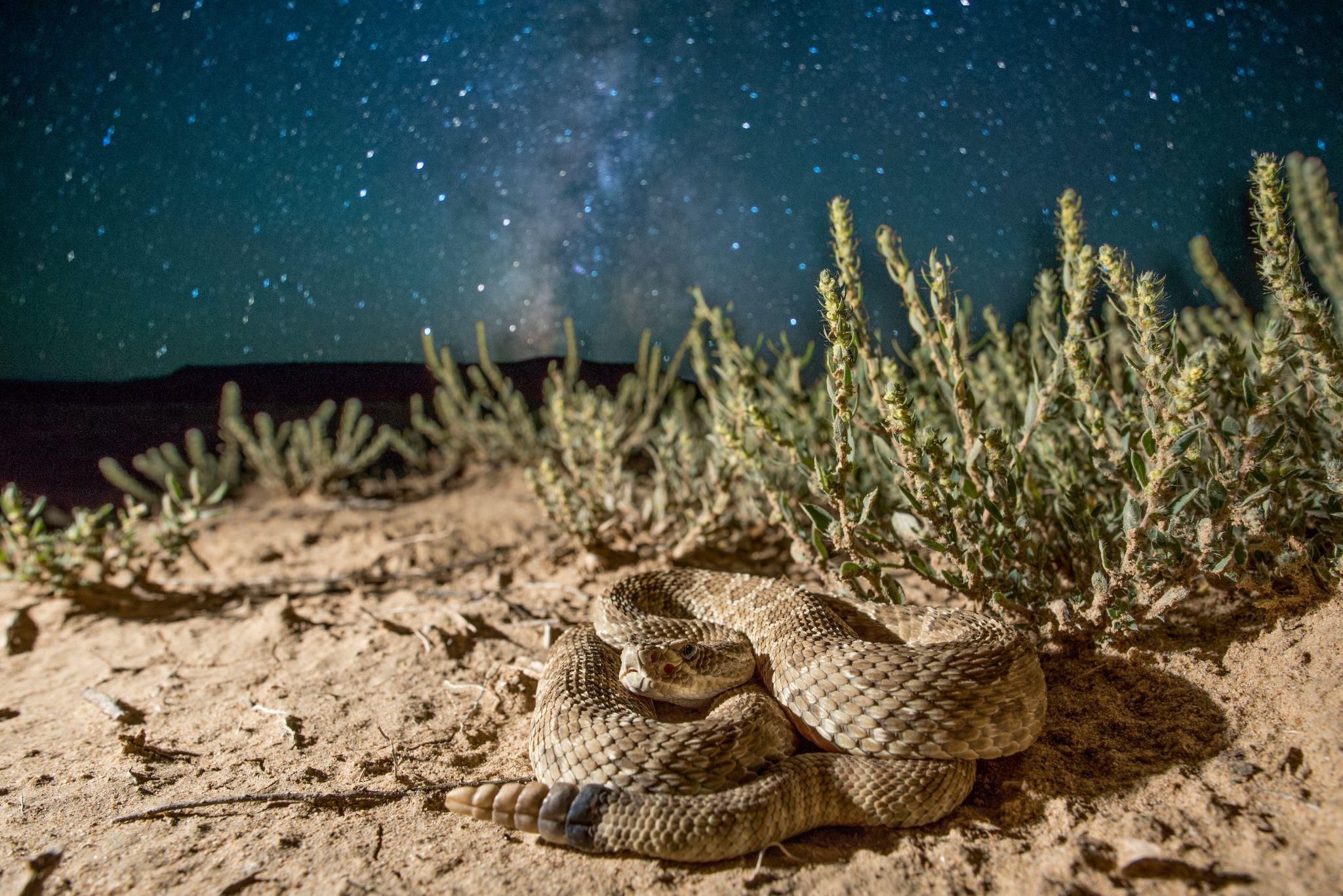
Credit: Bill Gorum
Description
The prairie rattlesnake is one of the more commonly encountered snakes in New Mexico. The most noticeable characteristic is the light brown or tan background with a repeating pattern of darker blotches along the length of the back. On the head, a white (or light tan) stripe begins just behind the eyes and is usually accompanied by a dark blotch below it. While it lacks the distinct black and white banding seen on the tails of other species, there is often some faint dark banding present on the tail.
Similar Species
Prairie rattlesnakes are often confused with western diamondback rattlesnakes due to the somewhat similar color and pattern on the back. However, they can be easily distinguished because the prairie rattlesnake lacks the black and white tail banding that is present on western diamondbacks.
Another species that can cause confusion is the Mojave rattlesnake. In fact, in areas of New Mexico where both species are present, such as Hidalgo County, most of the prairie rattlesnakes are likely hybrids between the two. Though the bites of both of these species should be taken very seriously, the venom of Mojave rattlesnakes is especially potent and potentially life-threatening. If you are bitten by either species, seek medical attention immediately.
Geographic Distribution in New Mexico
The most widespread species of venomous snake in New Mexico, this is an animal that all residents of New Mexico should be familiar with. It can be found in low- to mid-elevation areas in every New Mexico county.
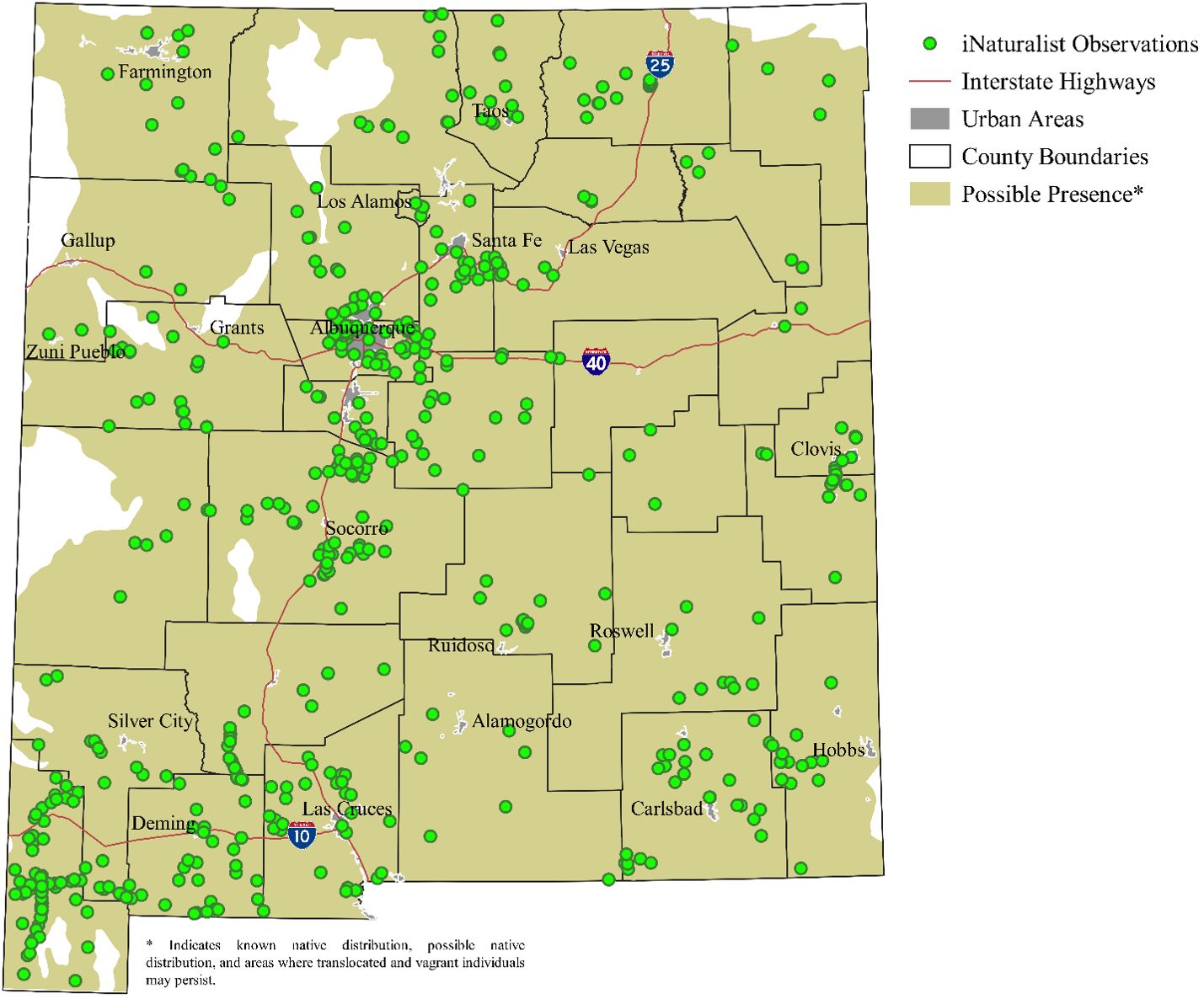
Credit: Brandon Bourassa, UF/IFAS
Habitat and Ecology
This species inhabits prairie, grassland, desert scrub, and wooded riparian habitat (habitat near rivers), such as the bosque of southern central New Mexico, across the entire state. Often associated with prairie dog towns or other mammal burrows (Figure 34E), the prairie rattlesnake uses preexisting shelter, whether dug by other animals or left on the ground by humans.
Prairie rattlesnakes feed primarily on rodents and lizards, though amphibians and ground-nesting birds will certainly be eaten if given the opportunity.
Additional Information
The vast distribution of this species, which extends north into parts of southern Canada and south well into Mexico, means that the type of venom, as well as its potency towards humans, has a high degree of variability. If prairie rattlesnakes in one part of their range rely heavily on rodents, like prairie dogs, they will probably have a venom that is more effective against mammalian prey. If they rely more heavily on lizards, they may have a venom that is more specialized for subduing reptiles. If you are bitten by this species, or any rattlesnake, you should seek medical attention immediately.

Credit: Bill Gorum
New Mexico Ridge-Nosed Rattlesnake (Crotalus willardi obscurus)
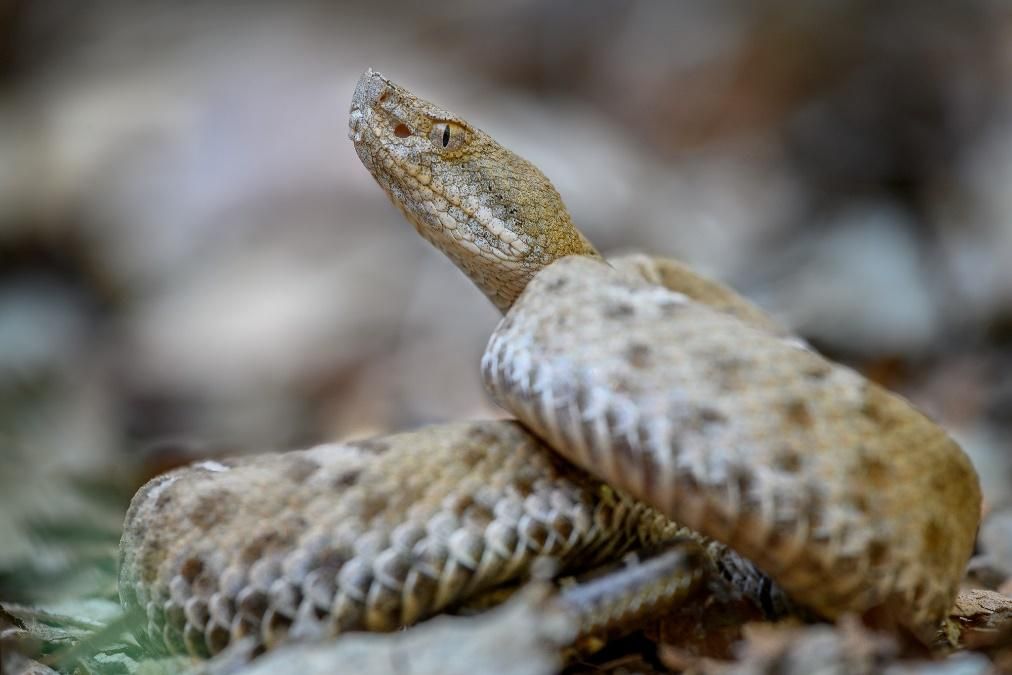
Credit: Bill Gorum
Description
The New Mexico ridge-nosed rattlesnake is a unique animal in New Mexico, possessing a gray to light-brown or reddish-brown body with white or tan crossbars that fade into the background as they extend toward the sides. Between the crossbars, which are edged in black, are darker brown blotches. The side of the body, below the blotches and crossbars, contains black or dark brown speckling.
Similar Species
The unusual ridge on the tip of the nose (Figure 35) easily distinguishes this species from other rattlesnakes in New Mexico. Other subspecies of ridge-nosed rattlesnakes do exist, but they are all found in Arizona and northern Mexico.
Geographic Distribution in New Mexico
In New Mexico, the New Mexico ridge-nosed rattlesnake is rare and seldom encountered. It occurs at high elevations in only the Peloncillo and Animas Mountains of Hidalgo County. Though its range does extend into portions of Arizona, the majority of the range extends into Mexico, through Chihuahua, with most of the range in Sonora.
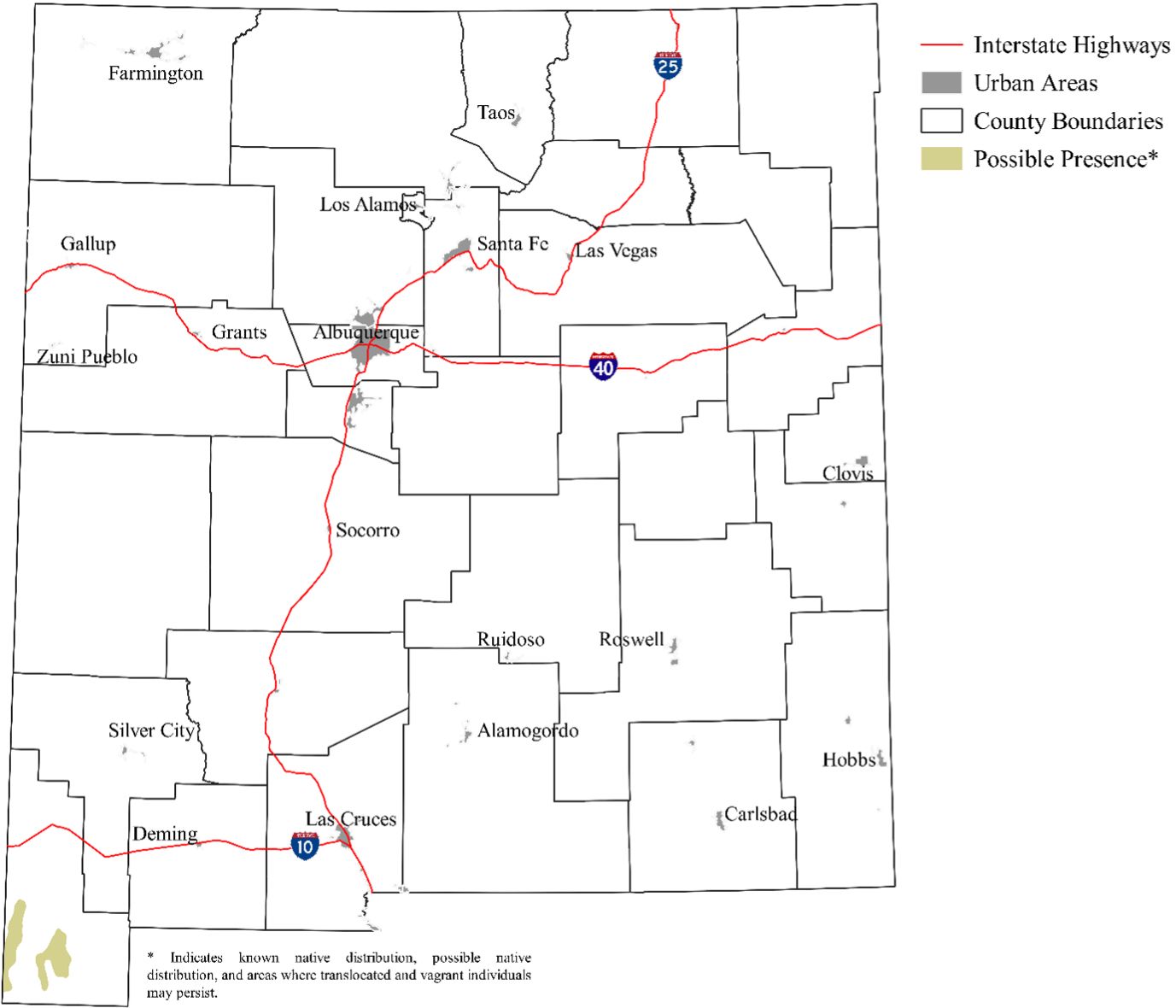
Credit: Brandon Bourassa, UF/IFAS
Habitat and Ecology
This rattlesnake inhabits canyons and wooded montane areas in extreme southwestern New Mexico. They can also be found in talus slopes (rockslides), which provide ample shelter, as well as a variety of prey items. Common prey items for this species in New Mexico include small lizards, such as the Yarrow’s spiny lizard (Sceloporus jarrovii), but they are also known to eat small mammals, birds, centipedes, insects, and scorpions. Young of this species possess yellow tails, which they use to lure in potential prey; a behavior called “caudal luring.”
Additional Information
You might be wondering why this subspecies is named after New Mexico when the bulk of its range is in Arizona and northern Mexico. Of the five currently recognized subspecies of Crotalus willardi, only two reside north of the border with Mexico in the United States. The other is the Arizona ridge-nosed rattlesnake (Crotalus willardi willardi). Since the remaining three subspecies (C. w. amabilis, C. w. meridionalis, and C. w. silus) all occur exclusively in Mexico, it makes sense to differentiate C. w. obscurus by noting in the common name that it is the only subspecies that inhabits New Mexico.
As mentioned before, these animals are very rare and seldom encountered. If you happen to come across one, please keep a safe distance and take a photograph. Record the geographic location (GPS coordinates are ideal), habitat information, time of day, weather conditions, and any other information that might be useful. This information can be extremely useful to researchers trying to learn more about the ecology and distribution of this elusive snake. The data that you record will likely be of interest to students and faculty at the Museum of Southwestern Biology at the University of New Mexico. If you decide to post your observation on iNaturalist, it is common practice to obscure the location for this species so potential poachers do not have access to precise locations. As a protected species in New Mexico, it is best to keep your distance and enjoy such a rare encounter by observing from a safe vantage point.
If you are bitten by this species, or any rattlesnake, you should seek medical attention immediately.
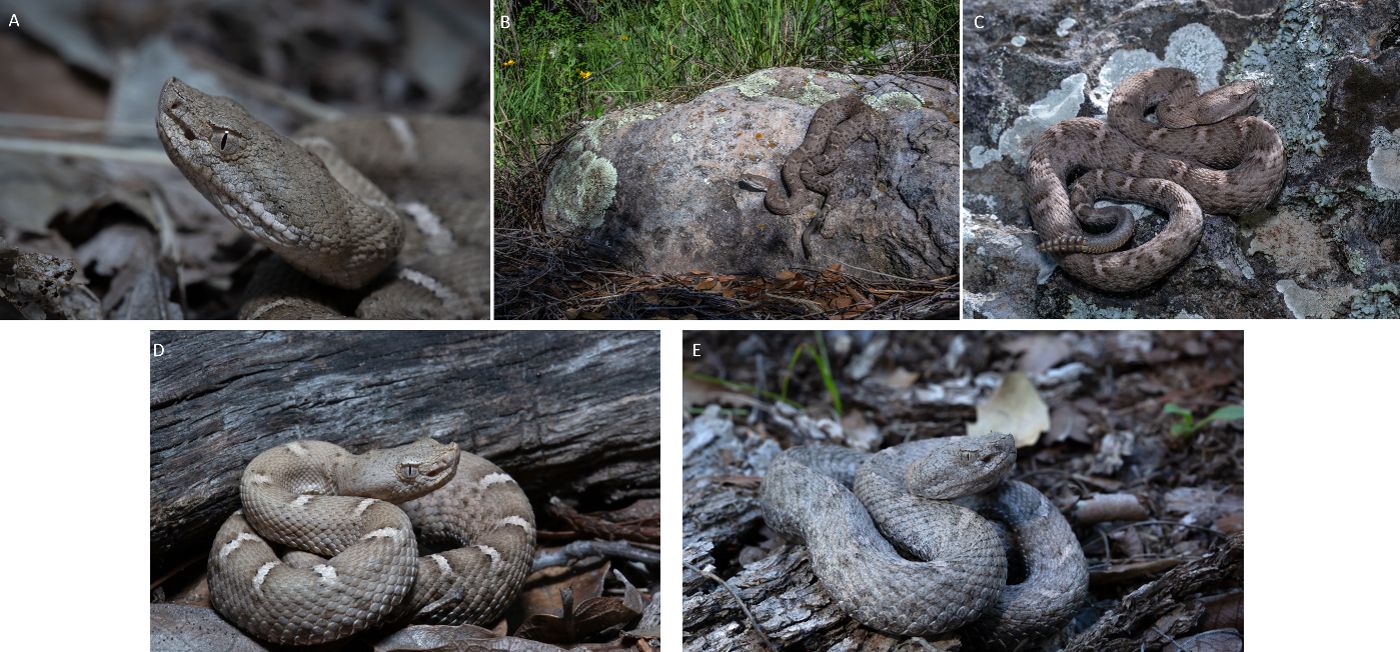
Credit: Bryan Hughes, Rattlesnake Solutions
Western Massasauga (Sistrurus tergeminus)
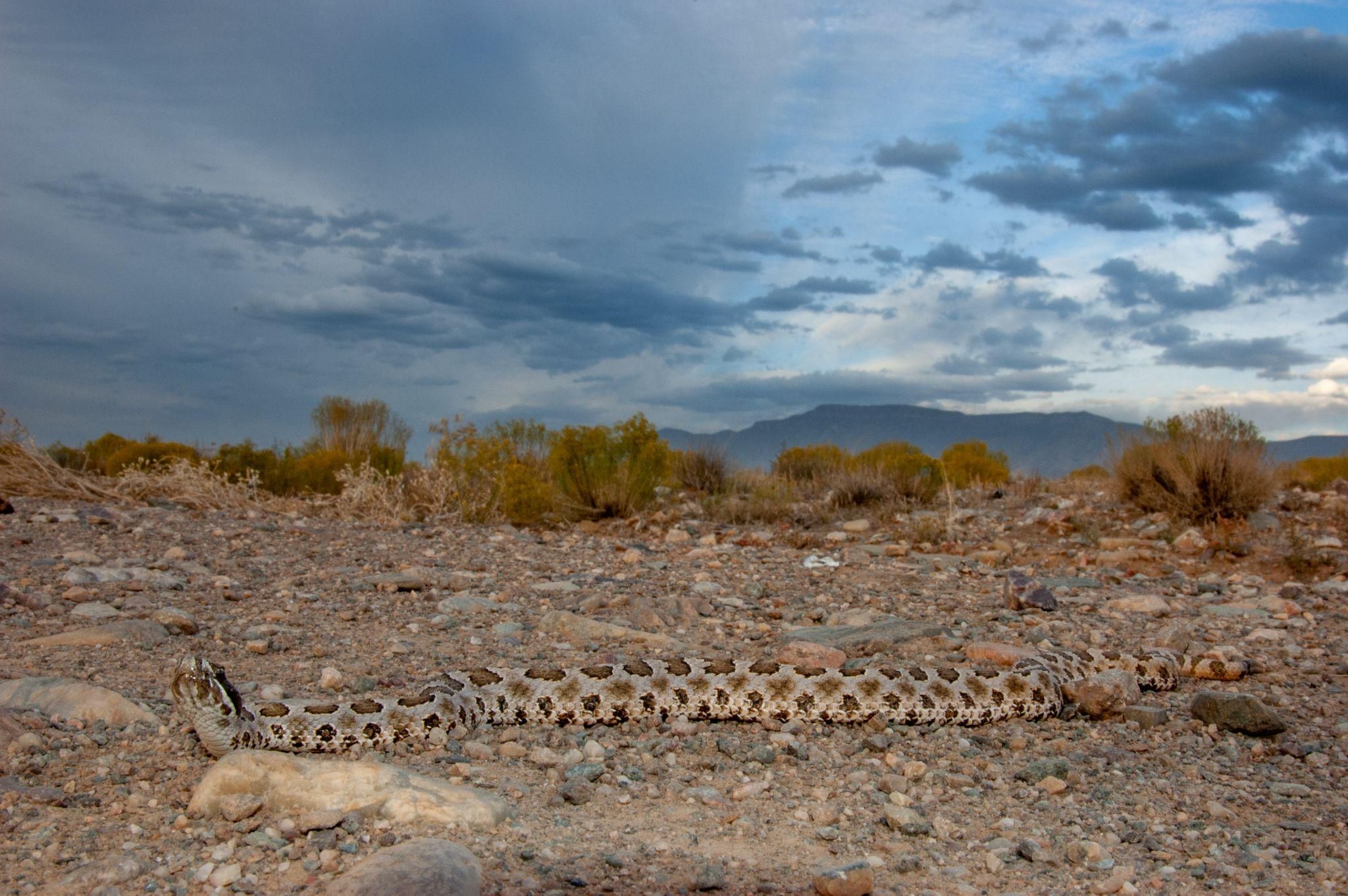
Credit: Bill Gorum
Description
At 14 to 32 inches long, the western massasauga is one of the smaller species of rattlesnakes in New Mexico. The background coloration on the body is a light gray or brown, and the top of the body is adorned with dark brown oval or irregularly shaped blotches down the length of the back (Figure 38). Along the length of the sides of the body are another two rows of smaller dark brown blotches. From each eye, a dark brown bar with white edges extends to the back of the head.
Similar Species
The western massasauga is easily mistaken for a small prairie rattlesnake due to the strikingly similar colors and patterns. The bottom of the lower jaw of a massasauga often features more dark brown markings, whereas prairie rattlesnakes are usually white on the bottom of the lower jaw. The best way to distinguish the western massasauga from other rattlesnakes is by the nine large scales on top of the head between the eyes. The obvious issue with this method is the close proximity of the observer, so we recommend one of these alternative methods. The larger the animal, the more likely it is to be a prairie rattlesnake. Also, when approached, a massasauga may lift its head to a 45° to 90° angle as a warning (Figure 38). Other rattlesnakes in New Mexico will generally rise up into a defensive posture and lower their heads, whereas massasaugas tend to remain coiled with their heads pointed upwards. This warning may also present as a jerky, “bobbing” motion.
Geographic Distribution in New Mexico
The western massasauga inhabits low- to mid-elevation areas (around 3,500-4,600 feet) throughout much of central and southern New Mexico.
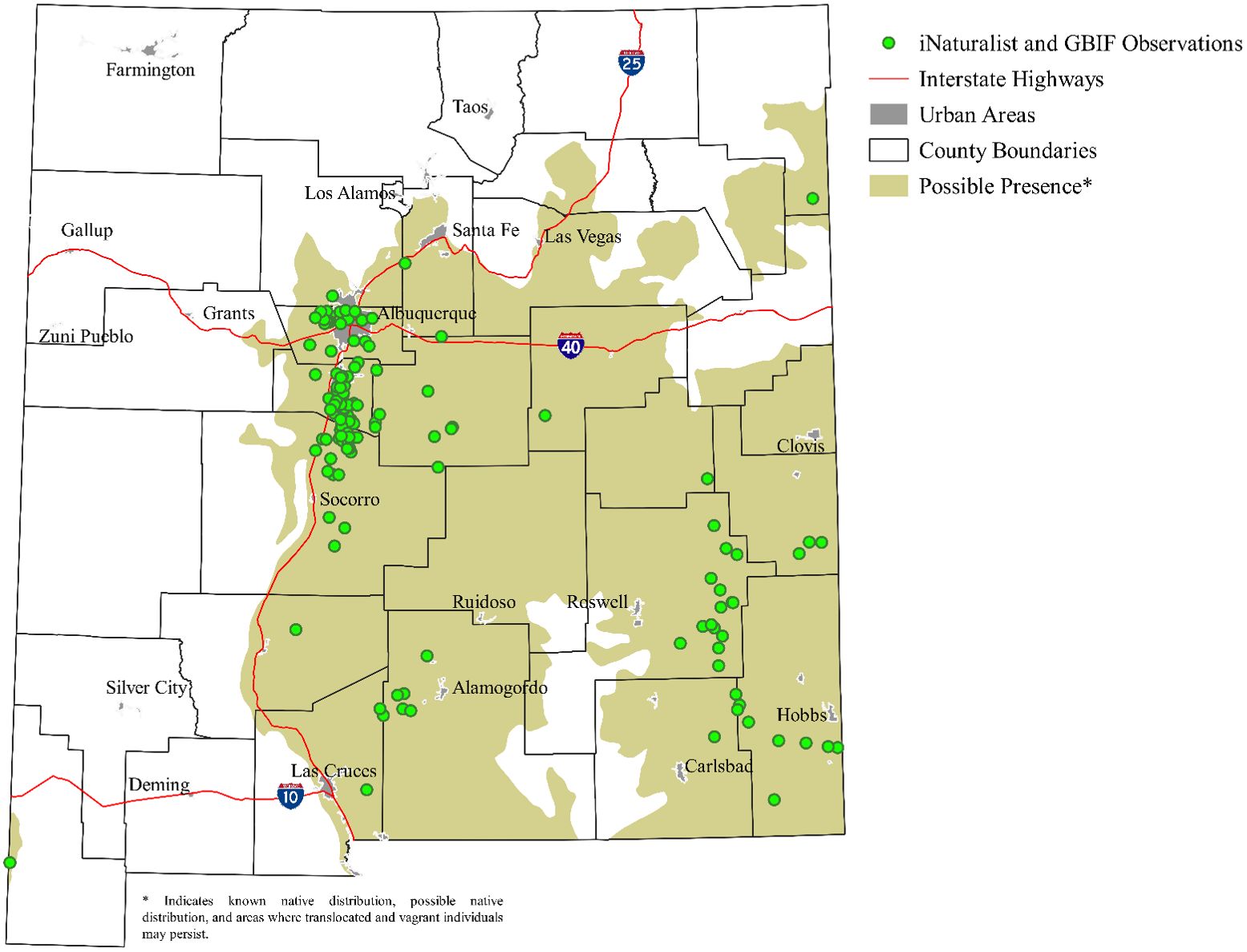
Credit: Brandon Bourassa, UF/IFAS
Habitat and Ecology
This rattlesnake prefers semidesert grasslands and valleys. Prey includes lizards, small rodents, amphibians, and some invertebrates like centipedes. This is a primarily nocturnal species that uses rodent or small mammal burrows for shelter during the day, as well as hibernation during the winter. Juveniles possess bright yellow or greenish tails (Figure 40C), which they use to lure in unsuspecting prey, a technique called “caudal luring.”
Additional Information
Several research projects are underway to better understand the ecology of the western massasauga in New Mexico. If you come across one, keep a safe distance, but try to get a photo and upload it to iNaturalist. Location data that you provide can and will be used by actual researchers working on these animals.
If you are bitten by this species, or any rattlesnake, you should seek medical attention immediately.
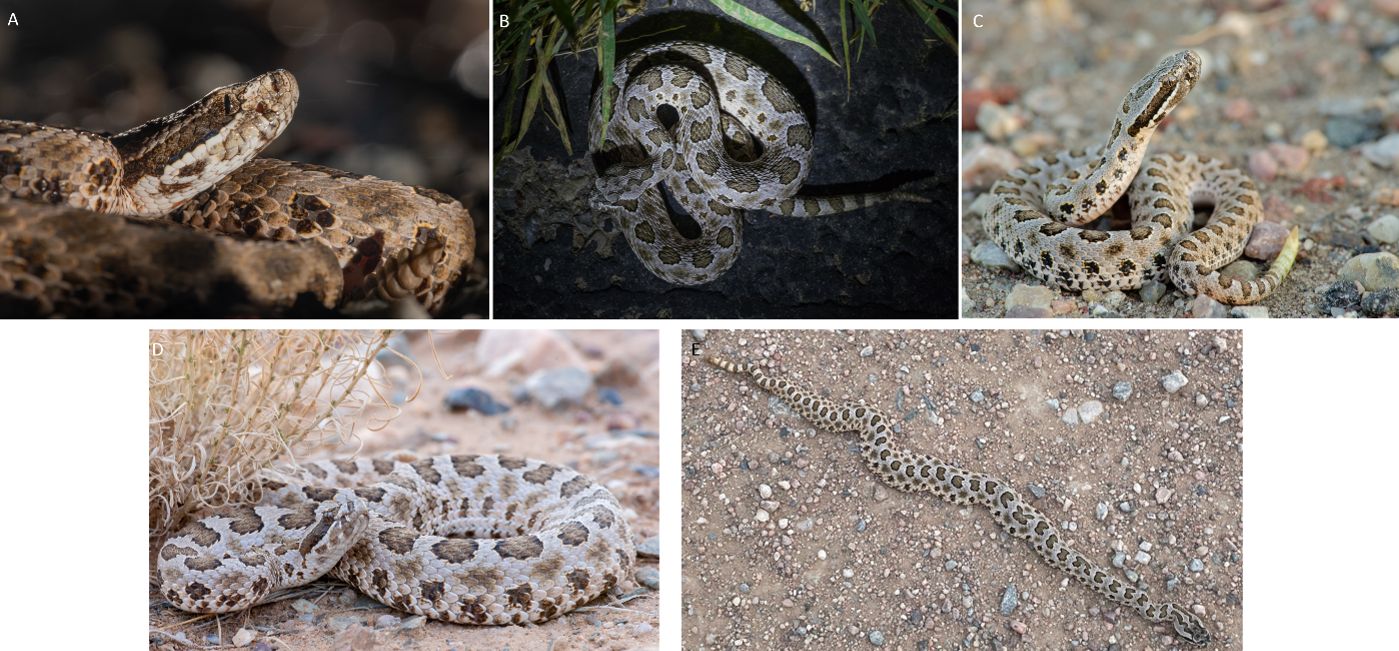
Credit: A, C, and D. Bill Gorum; B. Aaron Border; E. Sandy Young
Commonly Misidentified Harmless Snakes
The snakes in this section have been selected based either on their similarities to the venomous species covered previously or their likelihood to be misidentified based on similar habitat, behavior, or ecology. While it may be a bit overwhelming to try to learn every harmless snake in New Mexico, hopefully this section will provide you with an introduction to the other snakes found in the state.
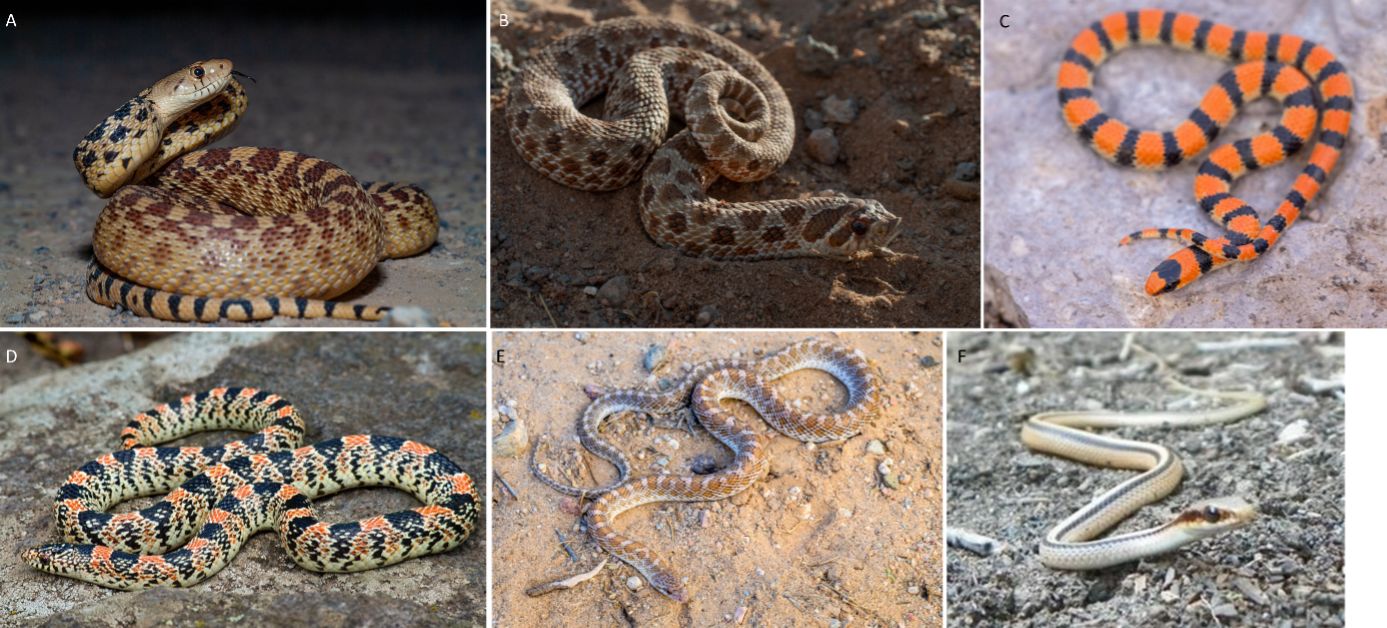
Credit: A, B, C, D, and E. Bill Gorum; F. Josh Emms
(Figure 41A) Gopher snakes and bull snakes (Pituophis spp.)
These large snakes are commonly mistaken for rattlesnakes because of their defensive displays, in which they hiss loudly and vibrate their tail, sometimes creating a rattling sound if it is vibrating against something. Of course, the most obvious way to tell that any harmless snake is not a rattlesnake is the lack of a rattle. Even if a rattlesnake has broken its rattle, there are usually one or two segments remaining that can give it away.
(Figure 41B) Hognose snake (Heterodon spp.)
The pattern of these snakes can look extremely similar to a small prairie rattlesnake or western massasauga. The upturned snout (which many people find to be adorable), used for digging, is an immediate giveaway that you are looking at a harmless hognose snake. If harassed these snakes may hiss loudly, flatten their head, and put on a bluffing display (they rarely actually bite, but their bites can cause mild swelling). In some cases, these little over-actors will roll over, hang their tongues out of their mouths, emit a foul-smelling musk, and play dead until the potential threat passes.
(Figure 41C) Ground snake (Sonora semiannulata)
These beautiful little snakes can sometimes be mistaken for coral snakes. However, they are quite variable, and the tri-colored variant is generally red with narrow black crossbands. The pattern on the back may fade into the yellow belly. This is why the “red touches yellow, kill a fellow” adage is unreliable.
(Figure 41D) Long-nosed snake (Rhinocheilus lecontei)
This is another gorgeous tri-colored species that is sometimes mistaken for a coral snake, and another exception to the “red touches yellow, kill a fellow” adage. The back of the snake is generally patterned with red and black crossbands fading into a yellow belly. The sides of the snakes have smaller black bands coming up from the belly.
(Figure 41E) Glossy snakes (Arizona elegans)
This slender snake is sometimes mistaken for a small rattlesnake, like a prairie rattlesnake or western massasauga. The head is more elongated than that of a rattlesnake, and the smooth, shiny scales are another good way to distinguish them (rattlesnake scales are generally rough and unreflective).
(Figure 41F) Patchnose snakes (Salvadora spp.)
This snake may be persecuted because of their association with communal dens that they often share with rattlesnakes. The large scale on the tip of the snout, which gives these snakes their common name, as well as the long, narrow body with a solid yellow stripe between two black stripes all the way along the length of the back distinguish this snake from its venomous neighbors.

Credit: A, C, D, and F. Bill Gorum; B. Josh Emms; E. Jerry Tuttle
(Figure 42A) Trans-Pecos ratsnake (Bogertophis subocularis)
These long, slender snakes may be mistaken for rattlesnakes because of their light brown or yellowish coloration and repeating pattern of darker brown blotches (more like hourglasses than diamonds). They often have solid black lines on both sides of the back starting at the neck and running the length of the body, though they may fade about halfway down. The head is elongate, and the large, gray eyes protrude from their sockets.
(Figure 42B) Lyre snakes (Trimorphodon spp.)
These small snakes can easily be mistaken for rock rattlesnakes or young black-tailed rattlesnakes. The body is much more slender than a black-tailed rattlesnake, and the lack of a rattle should also be an obvious indicator that it is not a rattlesnake.
(Figure 42C) Night snakes (Hypsiglena jani)
Night snakes, especially the Texas night snake (Hypsiglena jani texana) may be mistaken for mottled rock rattlesnakes. However, the two species only overlap in a small area of southeastern New Mexico. These snakes are small and generally have three bold, dark stripes just behind the head that can help to differentiate them from rattlesnakes, as well as the obvious lack of a rattle at the end of the tail.
(Figure 42D) New Mexico milk snake (Lampropeltis triangulum celaenops)
These snakes can easily be confused for a coral snake, but the “red on black, venom lack” adage is actually relevant here. The tri-colored banding pattern of these snakes follows a reliable pattern of black, yellow, black, red, black, yellow, black, etc.
(Figure 42E) Gray-banded kingsnake (Lampropeltis alterna)
These attractive snakes can be quite variable. One of these variations (pictured) can appear very similar to the rock rattlesnake. However, note the smooth, reflective scales of the kingsnake and the lack of a rattle.
(Figure 42F) Arizona mountain kingsnake (Lampropeltis pyromelana)
This is another tri-colored species for which the “red on black, venom lack” adage works. Another feature that distinguishes the Arizona mountain kingsnake from coral snakes is the white (or yellowish white) snout. Coral snakes (and milksnakes) possess black snouts. The “yellow” bands in the tri-colored pattern may be closer to white as well.
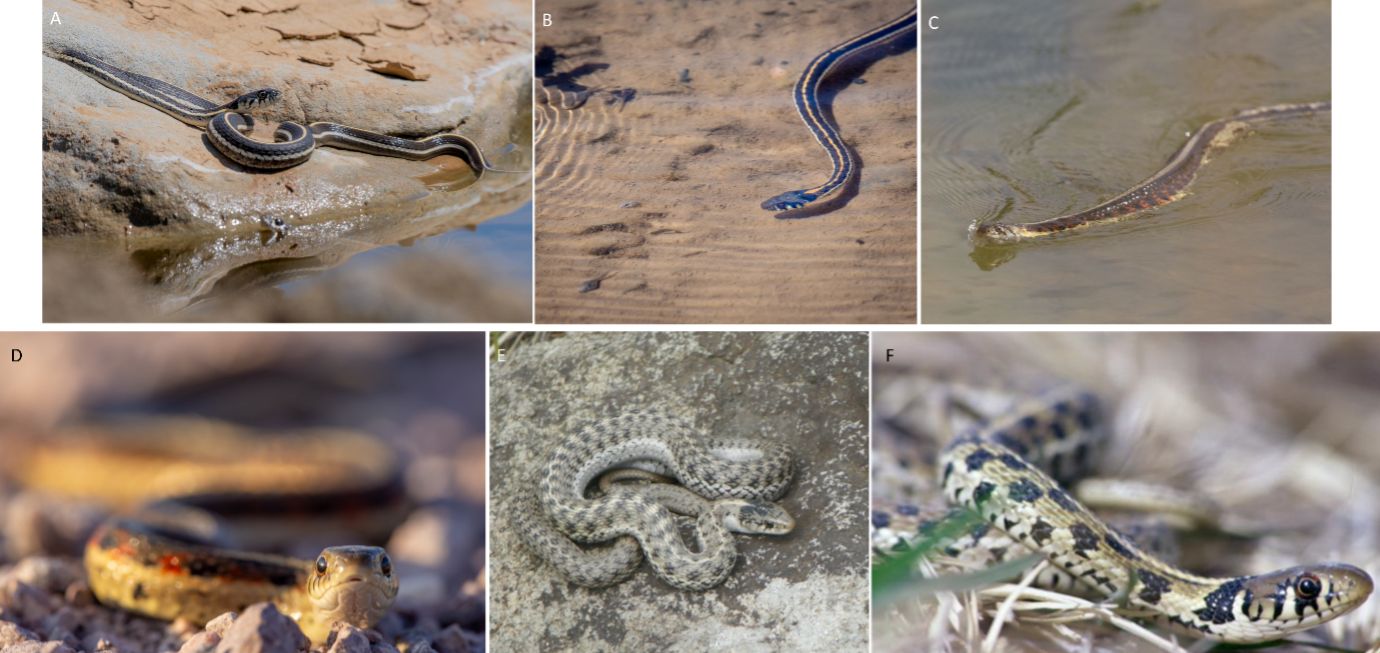
Credit: Bill Gorum
(Figure 43) Garter snakes (Thamnophis spp.)
Garter snakes, commonly called garden snakes, are one of the more well-known groups of snake species in the United States. New Mexico is home to several species and subspecies. While they tend to be associated with water, some species, like the western terrestrial garter snake, can be found in wooded areas and open prairies.
Further Reading and Other Helpful Resources
Anderson, C. G., and E. Greenbaum. 2012. “Phylogeography of Northern Populations of the Black-Tailed Rattlesnake (Crotalus molossus Baird and Girard, 1853), With the Revalidation of C. ornatus Hallowell, 1854.” Herpetological Monographs 26 (26): 19–57. https://doi.org/10.1655/HERPMONOGRAPHS-D-11-00012.1
Brown, P.H.H. 2020. “Crotalus tigris (Tiger Rattlesnake): Geographic Distribution.” Herpetological Review 51 (1): 78.
Campbell, J. A., and W. W. Lamar. 2004. The Venomous Reptiles of the Western Hemisphere. Comstock Pub. Associates.
Degenhardt, W. G., C. W. Painter, and A. H. Price. 1996. Amphibians and Reptiles of New Mexico (1st ed). University of New Mexico Press.
New Mexico Herpetological Society - Snakes of New Mexico: http://nmherpsociety.org/reptiles/snakes/index.html
Painter, C. W., J. N. Stuart, J. T. Giermakowski, and L. J. S. Pierce. 2017. “Checklist of the Amphibians and Reptiles of New Mexico, USA, with Notes on Taxonomy, Status, and Distribution.” Western Wildlife 4:29–60.
Zancolli, G., J. J. Calvete, M. D. Cardwell, H. W. Greene, W. K. Hayes, M. J. Hegarty, H. –W. Herrmann, A. T. Holycross, D. I. Lannutti, J. F. Mulley, L. Sanz, Z. D. Travis, J. R. Whorley, C. E. Wüster, and W. Wüster. 2019. “When One Phenotype Is Not Enough: Divergent Evolutionary Trajectories Govern Venom Variation in a Widespread Rattlesnake Species.” Proceedings of the Royal Society B: Biological Sciences 286:20182735. https://doi.org/10.1098/rspb.2018.2735
Acknowledgments
We would like to thank the incredible photographers who have graciously contributed their work to this project. We acknowledge the hard work and tremendous patience that goes into finding these animals in the field, let alone capturing the amazing photos that you have seen in this publication. Bill Gorum, Bryan Hughes, Richard Reams, Wolfgang Wüster, Kyle Vargas, Ashley Wahlberg, Sandy Young, Aaron Border, Buddy Brown, Joshua Emms, Jerry Tuttle, and Chris Cirrincione have all contributed their work.
We would also like to thank the members and friends of the New Mexico Herpetological Society and members of the Residential Landscape Ecology Lab (Jesse Jones, Brooke Moffis, Kacey Russo, Olesya Malakhova, and Johanna Walker) in the School of Forest, Fisheries, and Geomatics Sciences at the University of Florida for their comments and suggestions. Wolfgang Wüster, Richard Reams, Leland Pierce, and the Herpetology team at the ABQ BioPark (Keith Crow, Stacey Sekscienski, Joshua Butler, Phil Mayhew, and Chris Cadieux) also provided useful feedback.